Kristine Hughes's Blog, page 111
April 5, 2013
***The Secrets of Bloxley Bottom, Episode 9: Polly Is Ready for a Risk
 We’ve had eight episodes of The Secrets of Bloxley Bottom since our launch on Feb. 15, 2013. Time to take a look back at the story so far.
We’ve had eight episodes of The Secrets of Bloxley Bottom since our launch on Feb. 15, 2013. Time to take a look back at the story so far.The Secrets of Bloxley Bottom
Lots of secrets are swirling around the village. Miss Prudence Newton guards her ambitions behind a facade of propriety…a façade which might be breached before long. Major Monty Twydall has been keeping his fiscal difficulties close to his vest …and the French émigré artist Pierre Tournell is consumed with his undisclosed ambitions in all their varieties. Lionel, Lord Bloxley needs to protect several casual encounters from his wife’s knowledge, and in turn, Elizabeth, Lady Bloxley has surprises of her own she may yet share someday.
The Bloxley daughters, Daphne and Valeria, shared a secret about their grandmamma, the Dowager Baroness – and also about their parents, which they found delightfully romantic. Aurelia and Millicent enjoy collecting tidbits of gossip, secret or not, and sharing them with everyone. Miss Anne Humphrey, companion to the dowager baroness Bloxley has a deep and significant secret she will guard with her very life. Whilst it is no secret at all that Lady Louisa openly organizes many of the village’s concerns, people would be amazed to know how the Dowager honors the many secrets of others. And what she has in store for Prudence. Exactly the same is true of her dear friend, Arthur Wellesley, the first Duke of Wellington. Like Lady Louisa, the Duke knows when to watch his words.
The only resident of the village who appears to be entirely without secrets is the large and decidedly odd looking stray dog called Spot, although no one has a clue where he came from. We hope you are enjoying our blovel – a serialized story -- The Secrets of Bloxley Bottom. A new episode will appear each Friday. We will shortly putting a link to the Bloxely Bottom page in our sidebar. Be sure to look for it, as it will contain links to every chapter, as well as brief biographies of the principal characters.
Please share your comments on The Secrets of Bloxley Bottom and tell us what you think of the story so far.
 The Secrets of Bloxley Bottom Episode 9: Polly Is Ready for a Risk Polly Sawyer, maid of all work at the Crowing Cock, tucked the package addressed to Mrs. Oldstead-Parker into her wide apron pocket and began walking. At times like this she wished she had a wagon with a quick-stepping mare to hurry through her deliveries and chores.
The Secrets of Bloxley Bottom Episode 9: Polly Is Ready for a Risk Polly Sawyer, maid of all work at the Crowing Cock, tucked the package addressed to Mrs. Oldstead-Parker into her wide apron pocket and began walking. At times like this she wished she had a wagon with a quick-stepping mare to hurry through her deliveries and chores. Today she was eager to talk to Aurelia Gammersgill, a lady who was always kind and often offered her excellent advice. Because this time Polly’s problem was more than just a small question of how best to deal with her grandfather’s cantankerous moods or the unwelcome advances of men in the tap room. Today Polly had questions she was completely unprepared to answer. She had the feeling the requests of the artist, Mon-sir Tournell, would not be easily answered. Whether she said yes or no would have consequences far beyond her ability to see. But she yearned to say yes to him. Polly’s large green eyes and masses of curly, copper coloured hair usually brought her more attention than she wanted. Not to mention her generous curves. She knew the gazes of many men came to rest upon on the scarf she crisscrossed over her chest or the sash of her apron as it hung over her bottom. Mon-sir Tournell was the first person from France Polly had ever spoken to and she had to listen carefully when he spoke, for though he had a rich deep voice, his words were not pronounced quite as she expected them to be. He’d been at the inn for several days, eating alone some nights, others with Major Monty and his friends. He was always polite and smiled at her. Mam-zelle, he called her. She trudged up the gentle hill, past the bower of pink roses on a thatched cottage. A cat sunning herself on the stone wall raised her head and opened one eye for a moment before stretching and curling back into a ball. The street was quiet. Only a few ladies stood near the linen draper’s store and they were women who would not especially appreciate her greeting, so Polly kept her eyes on the road. This morning she’d brought Mon-sir a pot of strong coffee and a pitcher of warm milk along with a large cup and he had encouraged her to try his combination of part coffee and part milk. It was not half bad. He drank several before he wanted her to serve his morning bread and ham. When she set down the tray, Tournell had spoken companionably to her, asking after her health and that of her grandfather. Maybe Mrs. Winston, proprietor of the Crowing Cock, had told him about her grandfather and how he sometimes wandered off. “Perhaps you might tie a little bell onto his hat?” Polly had smiled at the suggestion. “Mam-zelle,” he’d said. “I would very much like to paint you.” She thought she’d misheard him. “Paint?” “I mean, make a picture of you.” Polly felt her cheeks warm remembering the way he’d looked at her when he said it. But she couldn’t tell Mrs. Gammersgill that. Aurelia Gammersgill did not approve of men who grinned at young gels and made them blush. Once at Aurelia's kitchen door, Polly's knock was answered by Bess, Mrs. Gammmersgill’s maid of all work, who stuck her head out the door and tried to grab the package. “Miz Winston sez I gotta give these into Mrs. Gammersgill’s hands,” Polly said. Actually she’d said nothing of the kind, but if Polly let her, Bess would keep her from seeing her friend and valued advisor. “Wait here.” Bess trudged into her kitchen. In moments, Aurelia drew Polly around the house to enter by the front door. “I saw you coming up the hill, my dear Polly,” she explained. Aurelia bustled Polly into the parlour and dispatched the sulky Bess to brew a pot of tea. Aurelia took the package and carefully inspected the information written there. She was always curious about Millicent’s mail order purchases, but would never stooped to unwrap one of them. Millicent would want to open it herself. She and Millicent Oldstead-Parker rubbed along very well, and Aurelia had no intention of rocking the boat. Only by sharing expenses could either of them live in a home as nice as Hilltop House, where they could enjoy all the privileges of a comfortable home, membership in a comfortable parish, visits with comfortable friends and a full gamut of comfortable gossip about the other residents of the comfortable neighborhood. There would be no boat rocking on her part. As intriguing as it looked, this package was Millicent’s and Aurelia now set it aside. Polly wore her white mob cap, the cap that Aurelia had advised her to change every day, along with her apron, which was always to be washed and carefully pressed. The sign of a good worker is a well turned out mode of dress. Like all her suggestions, Polly followed Aurelia’s advice faithfully. “Mr. Tournell asked if he could draw my picture, or paint me.” Aurelia immediately heard alarm bells ringing in her head. “He wants you to be his model?” “Yes, ma’am.” “And where would he paint you? At the inn?” “He didn’t say, but he usually paints at Major Monty’s, don’t he?” Aurelia was more than suspicious. But she did not want to frighten Polly. She was hardly more than a child. Only a Frenchman would be so wicked as to risk a young gel’s reputation, even a maid’s. “Now Polly, my dear, I would not recommend that you comply with the painter’s request unless he agrees to take your image at the inn, where you work and where there might always be others in close proximity. Under no conditions should you go to Major Monty’s to sit for him. Worse yet, do not have him come to your house. Think of how he would upset your grandfather.” Polly sat in silence for a few moments, thinking about what Mrs. Gammersgill said. “So you think I should agree if he does my pitcher at the inn?” “I think you might like him to make a picture of you. Am I correct?” Polly nodded. “I don’t know of anyone in Bloxley Bottom who wuz in a pitcher.” “I daresay you do not. I understand that you would like to see a picture of yourself, and I cannot say I blame you. Just be very careful, my dear. Mr. Tournell is from France and more than that need not be said.” After a cup of tea, her head spinning, Polly departed on her next errand for Mrs. Winston, heading to Hammersley's farm to pick up a few skinned rabbits for the inn's stewing pot.
Published on April 05, 2013 01:00
April 3, 2013
Planning Travel to Britain
Victoria here. I don't know about you, but after laughing myself silly over Kristine's posts about her recent trip to England, I am driven to start planning for my next jaunt. I've been trying to get across the pond almost every year but due to the Jubilee and the Olympics and the crowds expected, I decided to pass on 2012.
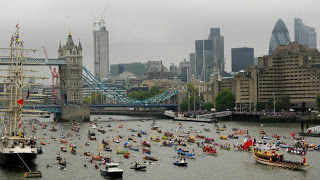
What a mistake! Instead I was glued to my tv, iPad and computer trying to take in all the festivities (and feeling sorry for myself because I was not there). Did you feel the same way when you saw the Queen cruising down the Thames with the flotilla of boats? Or when the British won medals in many sports, particularly the equestrian events? Or especially when the Queen came parachuting down from a plane over the Olympic stadium?

So I just can't miss 2013! Like Kristine, my usual traveling companion is my husband, who has seen a lot more of stately homes and art museums in England than he probably cared to, but he's a good sport and declared himself up for some more.
You realize, gentle readers, that Kristine and I have traveled together and would have absolutely no qualms about filling every day with sights to warm the hearts of every Anglophile. And eating only at teatime -- or when we are so exhausted we have to crash at a pub. Good thing there is always one nearby!
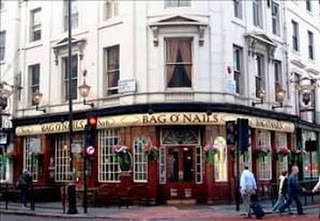
But Kristine and I can't always go together, and our husbands have a claim on some priorities! All of which is an introduction to my delicious choices ahead. I will have seven days in England, following a trip to Prague, Dresden, and Berlin this summer. I have never been to the former two and not to Berlin since the 1960's when it was still divided into zones, even preceding the infamous wall. Of course I was a mere baby, but I remember it well.
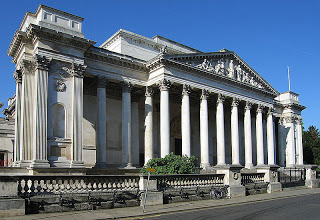 Fitzwilliam Museum, Cambridge University
Fitzwilliam Museum, Cambridge University
I am trying to put the various places I want to visit in some sort of coherent schedule. There are several places northeast of London that are high on my agenda: Cambridge, Holkham Hall, and Houghton Hall, maybe Sandringham.
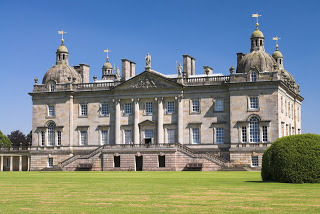 Houghton Hall, Norfolk
Houghton Hall, Norfolk
I've been searching through the websites of many London attractions which will have special exhibitions I want to see -- and a few spots on London outskirts that I have ever managed to visit, like Marble Hill House and Ham House.
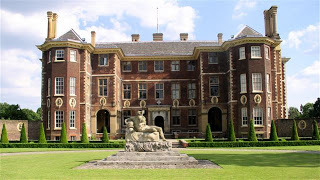 Ham House, Surrey
Ham House, Surrey
I have a pile of old magazines from Britain that I will consult...and I scour libraries for the newest and some of the oldest travel guides. Planning a trip is wonderful -- can I fit everything into my time schedule? Stay tuned for further musings.
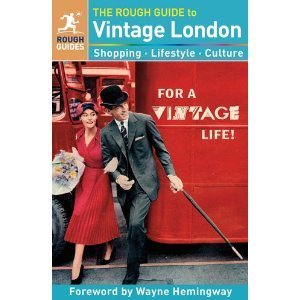 Available in May 2013
Available in May 2013

What a mistake! Instead I was glued to my tv, iPad and computer trying to take in all the festivities (and feeling sorry for myself because I was not there). Did you feel the same way when you saw the Queen cruising down the Thames with the flotilla of boats? Or when the British won medals in many sports, particularly the equestrian events? Or especially when the Queen came parachuting down from a plane over the Olympic stadium?

So I just can't miss 2013! Like Kristine, my usual traveling companion is my husband, who has seen a lot more of stately homes and art museums in England than he probably cared to, but he's a good sport and declared himself up for some more.
You realize, gentle readers, that Kristine and I have traveled together and would have absolutely no qualms about filling every day with sights to warm the hearts of every Anglophile. And eating only at teatime -- or when we are so exhausted we have to crash at a pub. Good thing there is always one nearby!

But Kristine and I can't always go together, and our husbands have a claim on some priorities! All of which is an introduction to my delicious choices ahead. I will have seven days in England, following a trip to Prague, Dresden, and Berlin this summer. I have never been to the former two and not to Berlin since the 1960's when it was still divided into zones, even preceding the infamous wall. Of course I was a mere baby, but I remember it well.
 Fitzwilliam Museum, Cambridge University
Fitzwilliam Museum, Cambridge UniversityI am trying to put the various places I want to visit in some sort of coherent schedule. There are several places northeast of London that are high on my agenda: Cambridge, Holkham Hall, and Houghton Hall, maybe Sandringham.
 Houghton Hall, Norfolk
Houghton Hall, NorfolkI've been searching through the websites of many London attractions which will have special exhibitions I want to see -- and a few spots on London outskirts that I have ever managed to visit, like Marble Hill House and Ham House.
 Ham House, Surrey
Ham House, SurreyI have a pile of old magazines from Britain that I will consult...and I scour libraries for the newest and some of the oldest travel guides. Planning a trip is wonderful -- can I fit everything into my time schedule? Stay tuned for further musings.
 Available in May 2013
Available in May 2013
Published on April 03, 2013 00:00
April 1, 2013
A Couple In England - Day Four - Part Three
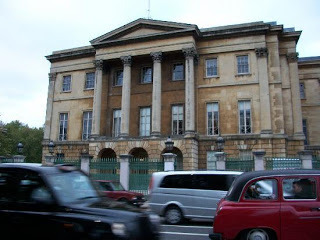
Hubby and I exited Apsley House to a grey, cold and misty day. "Are we going to get a cab?" he asked, pulling his collar up. "Look, there's a cab now!" "We can't get a cab here." "Why not?" "Because the traffic comes whizzing by from Constitution Hill and Upper Grosvenor Street and goes round this circle at breakneck speed. No cabby worth his salt is going to slam on his brakes and make a hairpin turn into Apsley House just to pick us up." "We can get a cab there, at the next corner." "No. That's Park Lane. Half the cars that aren't headed straight down Piccadilly are going to speed their way round that corner and up Park Lane. It's not an ideal spot for a cab to stop. We've got to go back through the pedestrian walkway and come out on the other side of Park Lane. We'll be able to get a cab there without taking our lives in our hands." "I don't want to do that underground walkway. I hate the underground walkway. There are homeless people in the underground walkway." "One. There's occasionally one homeless person sleeping in the underground walkway. Don't worry, I'll protect you." "Har har." We made it safely through the (empty) tunnel and out onto Piccadilly, where we flagged down the first cab we saw. "Trafalgar Square, please," I told the cabby. "Where in Trafalgar Square, love?" "Anywhere it's convenient," I told him. Before long we were traveling down the Mall, when up ahead I saw the Guards approaching on their way to the Palace. I quickly got out my camera and snapped the following picture as we drove by.
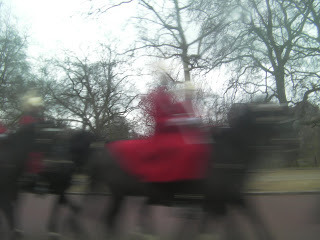
I tried, okay?
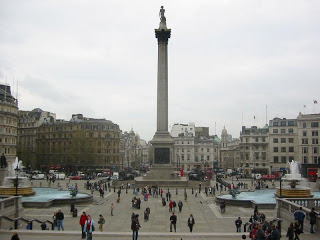
Before long we were in Trafalgar Square. "This place again? Weren't we just here?" Sigh. "We have time before the rock and roll tour starts. Are you hungry?" "Breakfast would be good." So I took Hubby to a crowded, storefront diner-type restaurant where they served English breakfast all day long. We fought our way over to a table for two and squeezed in between the other diners. Once we'd ordered, Hubby asked, "Why do you want to go on a three hour rock and roll tour, anyway? You hate rock music." "I booked the tour for you. So that you could do something you liked while we're in London." "You're going to be bored stiff." "No, I won't. I'll get to see parts of London I haven't seen before. It'll be interesting. Their website said we're going to see sights associated with The Who, Led Zeppelin, Pink Floyd, Mick Jagger, Jimmy Page." "You don't even know who Jimmy Page is."
"You don't know who Frederick Ponsonby is." "What band did he play with?" "Freddy Ponsonby?" "No! Jimmy Page. Go on, I'll give you ten dollars if you can tell me the name of his band." "I have no idea. I couldn't tell you if you offered me a million dollars." "My point exactly. You're going to be bored stiff."

At the appointed hour, we met our guide, Bob, and the rest of our group and boarded the tour bus. Bob gave us an overview of what we'd be seeing on the tour and of the music scene in London from the 1940's on. It went something like this, "Blah blah, blah blah blah. Yadda yadda yadda. Blah blah." Hubby had a broad smile on his face and seemed as happy as the proverbial clam. He grinned at me and I grinned back. "Yadda yadda, blah blah blah." I honestly can't tell you what we saw directly upon leaving the boarding point, but before I knew it, we were on Piccadilly, passing the Ritz Hotel. Then we were turning up Half Moon Street and passing our hotel. "That's our hotel," said Hubby. I nodded as we made a left turn onto Curzon Street and soon pulled up outside of 9 Curzon Place.
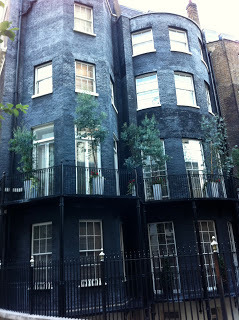
"Now that house of flats there," said Bob, pointing to it, "was an infamous party house. One of the flats was owned by singer and songwriter Harry Nilsson and everyone who was anyone to do with the music scene in the late 60's and 70's walked through that front door at one time or another. Nilsson's was flat number twelve and it was there on July 29, 1974 that Mama Cass Elliot died. And, four years later, Keith Moon died in that same flat, after which Nilsson sold the flat to Moon's bandmate, Pete Townsend."
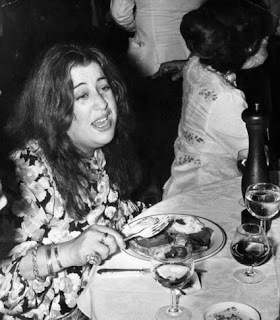
"You didn't know any of this?" Hubby asked in a slightly accusatory tone. "It's right down the street from our hotel." "No. I had no idea. If I'd known, I would have told you." I said a tad indignantly. "Sorry, my in depth knowledge of London stops at about 1901." We were on the move again and were soon passing a familiar landmark.
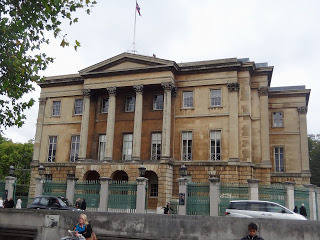
"Coming up on our right is the house known as Number One London, home to the Dukes of Wellington. Wellington, the first Duke that is, was of course the victor at the Battle of Waterloo in 1815, but the family also has ties to rock and roll. If anyone has heard of the duo Chad and Jeremy, Jeremy is a Wellesley and so has an aristocratic bloodline. He was a page boy at the Queen's coronation in 1953."
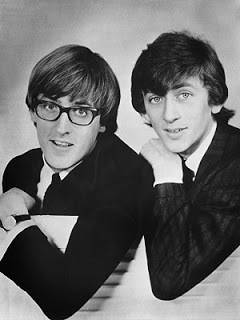
"Did you know that?" Hubby asked, rather in the same way a barrister might ask someone in the dock, "Where were you on the night of November 11, 2010?" "You know everything about Wellington down to his shoe size and you don't know about Chad and Jeremy? How could you not know it?" he persisted. "Er, it happened after 1901?" I've since discovered that Jeremy is Jeremy Clyde and his mother is Lady Elizabeth Wellesley, younger sister to the current Duke of Wellington. He's on the right in the photo above and I must say that his resemblence to the first Duke is uncanny. You can be sure that there will be a follow-up blog post on this soon. There was more blah, blah and yadda, yadda and then we found ourselves parked beside the Albert Hall, where Bob told us, "Blah blah, blah blah blah. Yadda yadda yadda. Blah blah, blah."
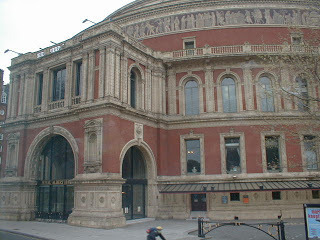
Next we headed for the King's Road. "This was King Charles II's private road to Kew. At that time, it was on the very outskirts of London and was very dangerous, indeed, and populated by cut throats and highwaymen." "Did you know that?" "Yes, I knew that." "But this," Bob went on, "is also where the heart of the music and fashion business was located beginning in the 1960's. Blah, blah, yadda, blah blah." Bob pointed out various sites along the Road: Mary Quant's former storefront, the Chelsea Drugstore, the former headquarters of Swan Song Records, blah, blah, blah. Then we made left off the King's Road and onto Old Church Street, where we stopped in front of the most interesting house below.
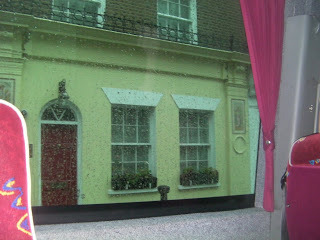 "Originally," Bob began, "this building was one of Chelsea's many dairies, but in 1964, the building down that alleyway behind this one became home to Sound Techniques recording studio, where a whole host of rock legends recorded. They included Elton John, Pink Floyd, Jethro Tull, The Yardbirds, The Who, yadda, yadda, blah, blah, blah." I tried to take good photos of the building, which has many architectural details, including decorative tiles at each end of the building. Unfortunately, the bus's windows were rain covered.
"Originally," Bob began, "this building was one of Chelsea's many dairies, but in 1964, the building down that alleyway behind this one became home to Sound Techniques recording studio, where a whole host of rock legends recorded. They included Elton John, Pink Floyd, Jethro Tull, The Yardbirds, The Who, yadda, yadda, blah, blah, blah." I tried to take good photos of the building, which has many architectural details, including decorative tiles at each end of the building. Unfortunately, the bus's windows were rain covered.
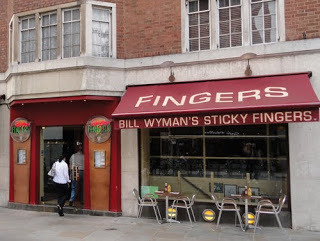 Soon after, we made a rest stop at Bill Wyman's Sticky Fingers bar and restaurant. I ordered us two welcome pints while Hubby used the restroom and then checked out the rock memorabilia lining the walls. "This is great, Hon." "Good. I'm glad you're having a good time." "How come you never took me to King's Road before? There's lot's of interesting stuff there." "When I think of the King's Road, I think shopping. When I think shopping, I don't think of you. You hate shopping."
Soon after, we made a rest stop at Bill Wyman's Sticky Fingers bar and restaurant. I ordered us two welcome pints while Hubby used the restroom and then checked out the rock memorabilia lining the walls. "This is great, Hon." "Good. I'm glad you're having a good time." "How come you never took me to King's Road before? There's lot's of interesting stuff there." "When I think of the King's Road, I think shopping. When I think shopping, I don't think of you. You hate shopping."
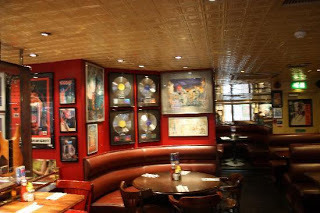 We all trooped back on the bus and the tour continued on to Notting Hill.
We all trooped back on the bus and the tour continued on to Notting Hill.
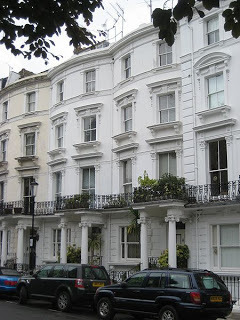 "We're now in Landsdowne Crescent, where the property prices have soared and where you currently see a row of pretty nice houses," Bob told us. "But in the 1960's, this was a really seedy part of London and most of these houses were flop houses and transient hotels. It is there, at number twenty-two where the Samarkand Hotel used to be and where Jimi Hendrix died on September 18, 1970." Bob went on to give us details of Hendrix's life and career that included such salient facts as yadda, yadda, yadda and blah, blah. Beside me, Hubby listened to Bob's every word. "Hendrix, Hon. Probably the greatest guitar player ever." Working hard to seem interested, I smiled and nodded in return.
"We're now in Landsdowne Crescent, where the property prices have soared and where you currently see a row of pretty nice houses," Bob told us. "But in the 1960's, this was a really seedy part of London and most of these houses were flop houses and transient hotels. It is there, at number twenty-two where the Samarkand Hotel used to be and where Jimi Hendrix died on September 18, 1970." Bob went on to give us details of Hendrix's life and career that included such salient facts as yadda, yadda, yadda and blah, blah. Beside me, Hubby listened to Bob's every word. "Hendrix, Hon. Probably the greatest guitar player ever." Working hard to seem interested, I smiled and nodded in return.
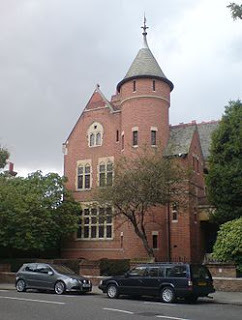 Next, we visited the site of Island Records and then the house above in Holland Park, which was built by architect William Burges. Actor Richard Harris purchased the house in 1968 and the current owner is Led Zeppelin guitarist Jimmy Page, which is why it was on our tour. "Jimmy Page," Hubby said, elbowing me in the side. "Led Zeppelin," I replied. "Give me ten dollars." "Too late."
Next, we visited the site of Island Records and then the house above in Holland Park, which was built by architect William Burges. Actor Richard Harris purchased the house in 1968 and the current owner is Led Zeppelin guitarist Jimmy Page, which is why it was on our tour. "Jimmy Page," Hubby said, elbowing me in the side. "Led Zeppelin," I replied. "Give me ten dollars." "Too late."
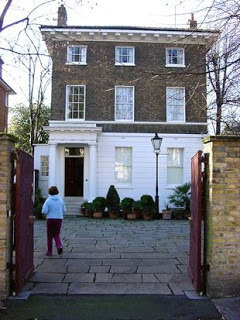 Next, we stopped in front of Paul McCartney's home in St. John's Wood, above.
Next, we stopped in front of Paul McCartney's home in St. John's Wood, above.
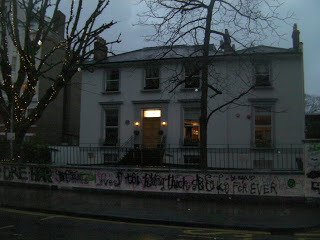 And by the time dusk was falling and the rain was coming down harder still, we arrived at Abbey Studios, where Bob gave us a talk about it's recording history. "Yadda, yadda, blah, blah, etc., etc., etc." "I can't believe it's all covered in graffiti," Hubby said. "I mean, it's Abbey Road, it's iconic and look what people have done to it." "It's an insult," I said. "Yeah." "Kinda like the dust on the centerpiece at Apsley House." Speaking of iconic, below is the Beatles Abbey Road album cover.
And by the time dusk was falling and the rain was coming down harder still, we arrived at Abbey Studios, where Bob gave us a talk about it's recording history. "Yadda, yadda, blah, blah, etc., etc., etc." "I can't believe it's all covered in graffiti," Hubby said. "I mean, it's Abbey Road, it's iconic and look what people have done to it." "It's an insult," I said. "Yeah." "Kinda like the dust on the centerpiece at Apsley House." Speaking of iconic, below is the Beatles Abbey Road album cover.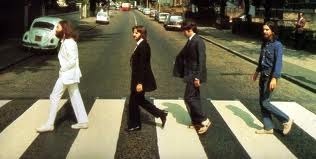 And this is what Abbey Road looked like when we arrived.
And this is what Abbey Road looked like when we arrived.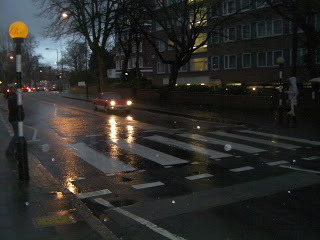 Abbey Road is not a quiet, backwater street. There's a bend in the road just before the Studio and traffic comes round it at a fairly brisk clip. Bob parked the bus at the side of the road and allowed those who so desired to recreate the famous walk across Abbey Road. "Go on," I told Hubby. "Nah. It's raining. And cold."
Abbey Road is not a quiet, backwater street. There's a bend in the road just before the Studio and traffic comes round it at a fairly brisk clip. Bob parked the bus at the side of the road and allowed those who so desired to recreate the famous walk across Abbey Road. "Go on," I told Hubby. "Nah. It's raining. And cold.""Go on. If you don't do it, you'll kick yourself later."
"You think?" "Yes. Go. I'll take your picture."
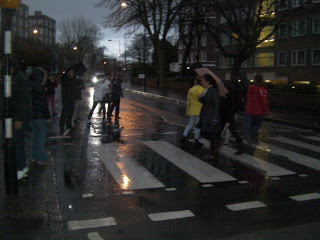 You can see Hubby's white shoes on the sidewalk to the left in the photo above.
You can see Hubby's white shoes on the sidewalk to the left in the photo above.
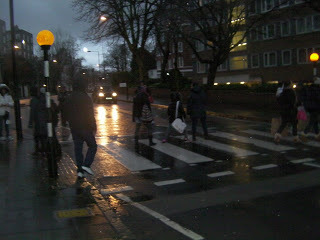
There's Hubby above, just entering the zebra crossing.
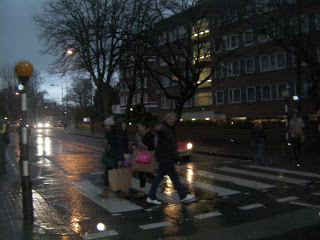 And here he is waving to the camera. With oncoming traffic approaching.
And here he is waving to the camera. With oncoming traffic approaching.
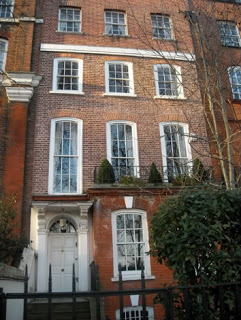 Our next stop was Mick Jagger's house in Cheyne Walk, Chelsea, above.
Our next stop was Mick Jagger's house in Cheyne Walk, Chelsea, above. 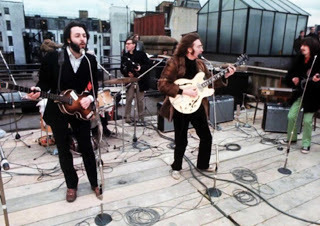
Our last stop was in Savile Row, where the Beatles played their final live concert on January 30, 1969 on the rooftop of the Apple building at 3 Savile Row.
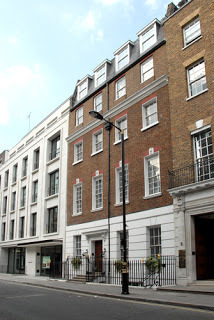
Obviously, I didn't take the photo above, because when we were there, it was dark and raining. Bob dropped us all off in Piccadilly Circus and we thanked him for his expert knowledge and a really great tour. "What now?" Hubby asked as we stood on the crowded sidewalk. "Now we go back to the hotel and have a drink, then we eat dinner and go to the theatre." "All that?" "Yes," I said, looking for a cab. "Do you want to eat at Burger and Lobster again?" "I don't know. Let's just get back to the hotel for now." Finally, a cab pulled up. "We're going to Half Moon Street," I told the cabby through the driver's window. He looked at me as though I had two heads. "It's only down the street a few yards. You could walk there." I then looked at him as though he had two heads and one of them was wearing a Viking helmet. Then I said, "I could walk to China, too, but I'm tired and it's raining and I'd rather take a cab. This is a cab, isn't it? And you are a cab driver, aren't you? Or am I mistaken?" "My good man," muttered Hubby. "I'll have to go all the way up to Oxford Street and double back," the cabby complained. "If you really want a ride, get in, but you really could walk." We got in. We went up to Oxford Street. We circled around Berkeley Square. We got to our hotel, got out and I paid the cabby. "That's the strangest thing that's ever happened to me in London," I told Hubby as the cab drove away. "Was that strange, or is it just me?" "It was strange, alright. And that wasn't just a few yards down the road. And it's raining." We stood on the pavement and stared at each other for a few moments, digesting what had just happened. "Let's go inside," Hubby suggested. "And have a stiff rum and coke." "Or two. My good woman." Part Four Coming Soon!
Published on April 01, 2013 00:00
March 29, 2013
The Secrets of Bloxley Bottom, Episode 8: Prudence Meets the Artist
Tournell pocketed his charcoals and held up his drawing to catch the light filtering through the windows of the taproom of the Crowing Cock Inn. Not bad, if he did say so himself. In the center of the page, he’d drawn three men at a table, based on the men who'd been seated across from him a half an hour ago. On the left he’d drawn, from memory, a lithe young girl holding a platter of ham. She closely resembled Polly, though he didn’t have the arms and hand quite right. Polly had a more graceful bearing than this figure. Working quickly, as he hadn't known how long the men intended to stay, and therefore unwittingly pose for him, Tournell had drawn in the details of the fireplace behind the men, the pictures that hung upon the wall, all in an effort to capture the feeling of the place, the verisimilitude that would give a painting character. Paintings of homey and rural scenes were at present proving most popular and were no doubt bringing ample funds to the coffers of their artists. There were many directions an artist might go these days. He wondered about his future and how best to secure his success. He was good at portraits. If he did the Bloxley daughters well, and the painting captured the interest of attendees at the Royal Academy next spring – If. If. If. Last night he and Monty had dined here, and he vowed to do more sketches, but not of females, as Monty intended. On a Sunday night, the inn had been quiet. Only the proprietress and the little maid Polly were about, so he'd returned this morning to try again. But he kept getting distracted by other ideas for paintings taken from everyday life. Polly would be perfect in a rural scene. And she could be a pretty fresh face among the roses or posed with a bowl of milk just as she looked now.
 He grabbed another piece of paper and pulled out his charcoals again, trying first to capture what he remembered of the shape of Polly’s face, her full cheeks and dimpled chin. Her eyes were bright and as blue as the summer sky, a blue that reminded him of his mother’s Sunday dress. How could he mix that color, luminous and deep? It would take several layers of paint, but his pots of paint were far away at Monty’s, and he had no way of getting there at the moment. Mrs. Winston came into the tap room, another lady he yearned to paint. Next to the face he was trying to make into a likeness of Polly, he sketched in a few lines to outline Mrs. Winston. Another good-looking woman in a sort of paradise of beautiful females. As she rearranged a shelf of bottles across the room, he took note of her lifted arms, reaching high over her head, the look of her heels and feet up on her tip toes. Ah, those feet, those legs in their cotton stockings. The human foot, now there was a subject for his pencils. Infinite variety of shapes. Long toes. Stubby toes. Gracefully arched feet or broad, flat feet. And upwards to the ankles, so fine or so plump.“Mrs. Winston,” a voice called from the serving pantry. Tournell knew all about the rooms behind the tap room, back of the house, they would have called it in a theater. He needed settings for his pictures, minutiae that would provide the kind of reality patrons wanted. He had an eye for detail.The voice belonged to another of the village’s pretty young women, les belle jeune filles. This was Prudence, the vicar’s daughter, another he’d love to paint. She had a long graceful neck and a fine figure.“I’ve brought the eggs, and your man is storing them in the larder. Is there anything else I can do for you?”Mrs. Winston met Prudence halfway across the room and Tournell again sketched a few lines to show the two women standing together.“Then I’ll be going now, Mrs. Winston. And deliver again on Wednesday.”Suddenly Tournell perked up and looked up from his papers and charcoal.“Miss Newton, are you going to the rectory?”“Yes, sir, I have finished my deliveries.”“I would appreciate a lift to Major Monty’s – is that on your return route?” He knew she would go past the estate Monty leased. “You could drop me at the roadside, if you would not mind.”Prudence Newton’s gray-blue eyes settled on him. She knew her mother would not approve. She’d often been warned not to provide a ride to anyone in the donkey cart. But she knew that Tournell was to paint the Bloxley sisters, and she was curious about it. How did one arrange a painting? It might be nice to have a little sketch of herself, something to give her parents.“You are welcome to accompany me,” Prudence said in her most careful accent, the voice that Lady Louisa had taught her for years to use in polite company. She knew Tournell the artist did not qualify as a proper companion, but he knew how the quality spoke. Driving the cart up the hill from the Inn with the artist beside her, Prudence wondered how to broach the subject of her portrait, not that she expected him to paint one without being paid handsomely for his efforts. But a sketch would be so very nice. She could ask their man of all work to craft a little frame for it and present it to her mother on her birthday. But how to ask? Tournell was contemplating almost the exact subject from the other point of view. How could he ask this pretty girl, who spoke with the voice of a young lady, to sit for him? Thus they proceeded in silence, until the dog Spot made his appearance, but the donkey was immune to Spot’s "Arp." “Mon Dieu,” Tournell muttered. “The first beast in Bloxley Bottom I don’t have the faintest intention of drawing. What hideousness!”Prudence laughed, glad at last the silence was broken. “Do you make little drawings besides your big paintings?”“Oui. Of course. Inside he was ecstatic. He didn’t have to say a word as it sounded like she was volunteering to pose for him. "Would you like a portrait of yourself, perhaps? A young lady as lovely as yourself should be captured in her prime."“I would like to have you make a picture of me for my mama’s birthday, a sketch perhaps, not a proper painting, but there's no question of my being able to afford your fees for even a simple a sketch, Monsieur Tournell. ”Tournell took a moment to consider his words, “I can do that for you. In place of my usual fee, you might allow me to sketch you for my own purposes? I do life studies for various compositions and often use them later on. Perhaps you can sit for me today?”“You mean now?”“Oui, if you have a spare hour.”Prudence thought for a moment. Her parents would begin to worry if she was not back by 3 pm. "Yes, sir, I have an hour or two."
He grabbed another piece of paper and pulled out his charcoals again, trying first to capture what he remembered of the shape of Polly’s face, her full cheeks and dimpled chin. Her eyes were bright and as blue as the summer sky, a blue that reminded him of his mother’s Sunday dress. How could he mix that color, luminous and deep? It would take several layers of paint, but his pots of paint were far away at Monty’s, and he had no way of getting there at the moment. Mrs. Winston came into the tap room, another lady he yearned to paint. Next to the face he was trying to make into a likeness of Polly, he sketched in a few lines to outline Mrs. Winston. Another good-looking woman in a sort of paradise of beautiful females. As she rearranged a shelf of bottles across the room, he took note of her lifted arms, reaching high over her head, the look of her heels and feet up on her tip toes. Ah, those feet, those legs in their cotton stockings. The human foot, now there was a subject for his pencils. Infinite variety of shapes. Long toes. Stubby toes. Gracefully arched feet or broad, flat feet. And upwards to the ankles, so fine or so plump.“Mrs. Winston,” a voice called from the serving pantry. Tournell knew all about the rooms behind the tap room, back of the house, they would have called it in a theater. He needed settings for his pictures, minutiae that would provide the kind of reality patrons wanted. He had an eye for detail.The voice belonged to another of the village’s pretty young women, les belle jeune filles. This was Prudence, the vicar’s daughter, another he’d love to paint. She had a long graceful neck and a fine figure.“I’ve brought the eggs, and your man is storing them in the larder. Is there anything else I can do for you?”Mrs. Winston met Prudence halfway across the room and Tournell again sketched a few lines to show the two women standing together.“Then I’ll be going now, Mrs. Winston. And deliver again on Wednesday.”Suddenly Tournell perked up and looked up from his papers and charcoal.“Miss Newton, are you going to the rectory?”“Yes, sir, I have finished my deliveries.”“I would appreciate a lift to Major Monty’s – is that on your return route?” He knew she would go past the estate Monty leased. “You could drop me at the roadside, if you would not mind.”Prudence Newton’s gray-blue eyes settled on him. She knew her mother would not approve. She’d often been warned not to provide a ride to anyone in the donkey cart. But she knew that Tournell was to paint the Bloxley sisters, and she was curious about it. How did one arrange a painting? It might be nice to have a little sketch of herself, something to give her parents.“You are welcome to accompany me,” Prudence said in her most careful accent, the voice that Lady Louisa had taught her for years to use in polite company. She knew Tournell the artist did not qualify as a proper companion, but he knew how the quality spoke. Driving the cart up the hill from the Inn with the artist beside her, Prudence wondered how to broach the subject of her portrait, not that she expected him to paint one without being paid handsomely for his efforts. But a sketch would be so very nice. She could ask their man of all work to craft a little frame for it and present it to her mother on her birthday. But how to ask? Tournell was contemplating almost the exact subject from the other point of view. How could he ask this pretty girl, who spoke with the voice of a young lady, to sit for him? Thus they proceeded in silence, until the dog Spot made his appearance, but the donkey was immune to Spot’s "Arp." “Mon Dieu,” Tournell muttered. “The first beast in Bloxley Bottom I don’t have the faintest intention of drawing. What hideousness!”Prudence laughed, glad at last the silence was broken. “Do you make little drawings besides your big paintings?”“Oui. Of course. Inside he was ecstatic. He didn’t have to say a word as it sounded like she was volunteering to pose for him. "Would you like a portrait of yourself, perhaps? A young lady as lovely as yourself should be captured in her prime."“I would like to have you make a picture of me for my mama’s birthday, a sketch perhaps, not a proper painting, but there's no question of my being able to afford your fees for even a simple a sketch, Monsieur Tournell. ”Tournell took a moment to consider his words, “I can do that for you. In place of my usual fee, you might allow me to sketch you for my own purposes? I do life studies for various compositions and often use them later on. Perhaps you can sit for me today?”“You mean now?”“Oui, if you have a spare hour.”Prudence thought for a moment. Her parents would begin to worry if she was not back by 3 pm. "Yes, sir, I have an hour or two."
The donkey plodded around the corner past Hilltop House.From the window, through the lace curtain, Aurelia Gammersgill watched the cart and its occupants. She pursed her lips in disapproval. That Frenchman. With the rector's daughter. Aurelia shook her head in genuine dismay. “Millicent, you won’t believe what I just saw,” she called to her house-mate.

 He grabbed another piece of paper and pulled out his charcoals again, trying first to capture what he remembered of the shape of Polly’s face, her full cheeks and dimpled chin. Her eyes were bright and as blue as the summer sky, a blue that reminded him of his mother’s Sunday dress. How could he mix that color, luminous and deep? It would take several layers of paint, but his pots of paint were far away at Monty’s, and he had no way of getting there at the moment. Mrs. Winston came into the tap room, another lady he yearned to paint. Next to the face he was trying to make into a likeness of Polly, he sketched in a few lines to outline Mrs. Winston. Another good-looking woman in a sort of paradise of beautiful females. As she rearranged a shelf of bottles across the room, he took note of her lifted arms, reaching high over her head, the look of her heels and feet up on her tip toes. Ah, those feet, those legs in their cotton stockings. The human foot, now there was a subject for his pencils. Infinite variety of shapes. Long toes. Stubby toes. Gracefully arched feet or broad, flat feet. And upwards to the ankles, so fine or so plump.“Mrs. Winston,” a voice called from the serving pantry. Tournell knew all about the rooms behind the tap room, back of the house, they would have called it in a theater. He needed settings for his pictures, minutiae that would provide the kind of reality patrons wanted. He had an eye for detail.The voice belonged to another of the village’s pretty young women, les belle jeune filles. This was Prudence, the vicar’s daughter, another he’d love to paint. She had a long graceful neck and a fine figure.“I’ve brought the eggs, and your man is storing them in the larder. Is there anything else I can do for you?”Mrs. Winston met Prudence halfway across the room and Tournell again sketched a few lines to show the two women standing together.“Then I’ll be going now, Mrs. Winston. And deliver again on Wednesday.”Suddenly Tournell perked up and looked up from his papers and charcoal.“Miss Newton, are you going to the rectory?”“Yes, sir, I have finished my deliveries.”“I would appreciate a lift to Major Monty’s – is that on your return route?” He knew she would go past the estate Monty leased. “You could drop me at the roadside, if you would not mind.”Prudence Newton’s gray-blue eyes settled on him. She knew her mother would not approve. She’d often been warned not to provide a ride to anyone in the donkey cart. But she knew that Tournell was to paint the Bloxley sisters, and she was curious about it. How did one arrange a painting? It might be nice to have a little sketch of herself, something to give her parents.“You are welcome to accompany me,” Prudence said in her most careful accent, the voice that Lady Louisa had taught her for years to use in polite company. She knew Tournell the artist did not qualify as a proper companion, but he knew how the quality spoke. Driving the cart up the hill from the Inn with the artist beside her, Prudence wondered how to broach the subject of her portrait, not that she expected him to paint one without being paid handsomely for his efforts. But a sketch would be so very nice. She could ask their man of all work to craft a little frame for it and present it to her mother on her birthday. But how to ask? Tournell was contemplating almost the exact subject from the other point of view. How could he ask this pretty girl, who spoke with the voice of a young lady, to sit for him? Thus they proceeded in silence, until the dog Spot made his appearance, but the donkey was immune to Spot’s "Arp." “Mon Dieu,” Tournell muttered. “The first beast in Bloxley Bottom I don’t have the faintest intention of drawing. What hideousness!”Prudence laughed, glad at last the silence was broken. “Do you make little drawings besides your big paintings?”“Oui. Of course. Inside he was ecstatic. He didn’t have to say a word as it sounded like she was volunteering to pose for him. "Would you like a portrait of yourself, perhaps? A young lady as lovely as yourself should be captured in her prime."“I would like to have you make a picture of me for my mama’s birthday, a sketch perhaps, not a proper painting, but there's no question of my being able to afford your fees for even a simple a sketch, Monsieur Tournell. ”Tournell took a moment to consider his words, “I can do that for you. In place of my usual fee, you might allow me to sketch you for my own purposes? I do life studies for various compositions and often use them later on. Perhaps you can sit for me today?”“You mean now?”“Oui, if you have a spare hour.”Prudence thought for a moment. Her parents would begin to worry if she was not back by 3 pm. "Yes, sir, I have an hour or two."
He grabbed another piece of paper and pulled out his charcoals again, trying first to capture what he remembered of the shape of Polly’s face, her full cheeks and dimpled chin. Her eyes were bright and as blue as the summer sky, a blue that reminded him of his mother’s Sunday dress. How could he mix that color, luminous and deep? It would take several layers of paint, but his pots of paint were far away at Monty’s, and he had no way of getting there at the moment. Mrs. Winston came into the tap room, another lady he yearned to paint. Next to the face he was trying to make into a likeness of Polly, he sketched in a few lines to outline Mrs. Winston. Another good-looking woman in a sort of paradise of beautiful females. As she rearranged a shelf of bottles across the room, he took note of her lifted arms, reaching high over her head, the look of her heels and feet up on her tip toes. Ah, those feet, those legs in their cotton stockings. The human foot, now there was a subject for his pencils. Infinite variety of shapes. Long toes. Stubby toes. Gracefully arched feet or broad, flat feet. And upwards to the ankles, so fine or so plump.“Mrs. Winston,” a voice called from the serving pantry. Tournell knew all about the rooms behind the tap room, back of the house, they would have called it in a theater. He needed settings for his pictures, minutiae that would provide the kind of reality patrons wanted. He had an eye for detail.The voice belonged to another of the village’s pretty young women, les belle jeune filles. This was Prudence, the vicar’s daughter, another he’d love to paint. She had a long graceful neck and a fine figure.“I’ve brought the eggs, and your man is storing them in the larder. Is there anything else I can do for you?”Mrs. Winston met Prudence halfway across the room and Tournell again sketched a few lines to show the two women standing together.“Then I’ll be going now, Mrs. Winston. And deliver again on Wednesday.”Suddenly Tournell perked up and looked up from his papers and charcoal.“Miss Newton, are you going to the rectory?”“Yes, sir, I have finished my deliveries.”“I would appreciate a lift to Major Monty’s – is that on your return route?” He knew she would go past the estate Monty leased. “You could drop me at the roadside, if you would not mind.”Prudence Newton’s gray-blue eyes settled on him. She knew her mother would not approve. She’d often been warned not to provide a ride to anyone in the donkey cart. But she knew that Tournell was to paint the Bloxley sisters, and she was curious about it. How did one arrange a painting? It might be nice to have a little sketch of herself, something to give her parents.“You are welcome to accompany me,” Prudence said in her most careful accent, the voice that Lady Louisa had taught her for years to use in polite company. She knew Tournell the artist did not qualify as a proper companion, but he knew how the quality spoke. Driving the cart up the hill from the Inn with the artist beside her, Prudence wondered how to broach the subject of her portrait, not that she expected him to paint one without being paid handsomely for his efforts. But a sketch would be so very nice. She could ask their man of all work to craft a little frame for it and present it to her mother on her birthday. But how to ask? Tournell was contemplating almost the exact subject from the other point of view. How could he ask this pretty girl, who spoke with the voice of a young lady, to sit for him? Thus they proceeded in silence, until the dog Spot made his appearance, but the donkey was immune to Spot’s "Arp." “Mon Dieu,” Tournell muttered. “The first beast in Bloxley Bottom I don’t have the faintest intention of drawing. What hideousness!”Prudence laughed, glad at last the silence was broken. “Do you make little drawings besides your big paintings?”“Oui. Of course. Inside he was ecstatic. He didn’t have to say a word as it sounded like she was volunteering to pose for him. "Would you like a portrait of yourself, perhaps? A young lady as lovely as yourself should be captured in her prime."“I would like to have you make a picture of me for my mama’s birthday, a sketch perhaps, not a proper painting, but there's no question of my being able to afford your fees for even a simple a sketch, Monsieur Tournell. ”Tournell took a moment to consider his words, “I can do that for you. In place of my usual fee, you might allow me to sketch you for my own purposes? I do life studies for various compositions and often use them later on. Perhaps you can sit for me today?”“You mean now?”“Oui, if you have a spare hour.”Prudence thought for a moment. Her parents would begin to worry if she was not back by 3 pm. "Yes, sir, I have an hour or two." The donkey plodded around the corner past Hilltop House.From the window, through the lace curtain, Aurelia Gammersgill watched the cart and its occupants. She pursed her lips in disapproval. That Frenchman. With the rector's daughter. Aurelia shook her head in genuine dismay. “Millicent, you won’t believe what I just saw,” she called to her house-mate.

Published on March 29, 2013 01:00
March 27, 2013
The Wellington Connection: Hedsor House
Director Dustin Hoffman's movie Quartet is garnering great reviews and stands as another in the "later life" genre of film that's become all the rage with people of a certain age. The fabulous and star studded cast includes the beloved Dame Maggie Smith, Billy Connelly, Pauline Collins, Tom Courtenay and Sheridan Smith as residents of stately Beecham House, a retirement home for impoverished singers and musicians.
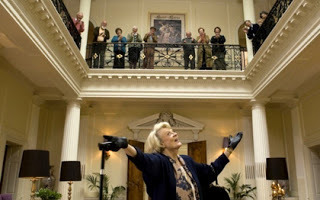
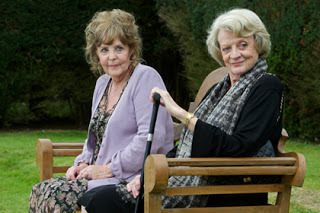 Not having seen the film yet, I plan on doing so this weekend, if only to see Dame Maggie, Billy Connelly (who, as a stand-up comic, is simply hysterical) and the much missed Pauline Collins. Sarah, where have you been?
Not having seen the film yet, I plan on doing so this weekend, if only to see Dame Maggie, Billy Connelly (who, as a stand-up comic, is simply hysterical) and the much missed Pauline Collins. Sarah, where have you been?
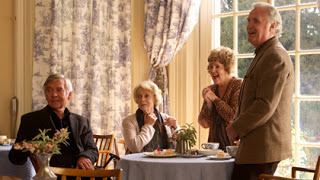 What, you may ask, does any of this have to do with the Duke of Welllington? Well, another of the film's stars is Hedsor House, which acts in Quartet as the fictional Beecham House, visible in the background of the photo below.
What, you may ask, does any of this have to do with the Duke of Welllington? Well, another of the film's stars is Hedsor House, which acts in Quartet as the fictional Beecham House, visible in the background of the photo below.
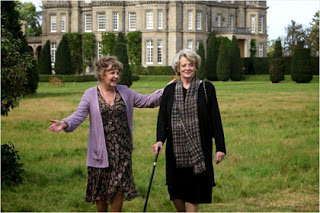 Hedsor House stands in the village of Hedsor, in Taplow, Buckinghamshire and dates back to the 12th century. In the 18th century, Hedsor House was occupied by Princess Augusta, Dowager Princess of Wales, mother of King George III and founder of Kew Gardens. In 1764, the house was purchased by William Irby, 1st Baron Boston, who also acquired the grounds, consisting of eighty-five acres overlooking the Thames.
Hedsor House stands in the village of Hedsor, in Taplow, Buckinghamshire and dates back to the 12th century. In the 18th century, Hedsor House was occupied by Princess Augusta, Dowager Princess of Wales, mother of King George III and founder of Kew Gardens. In 1764, the house was purchased by William Irby, 1st Baron Boston, who also acquired the grounds, consisting of eighty-five acres overlooking the Thames.
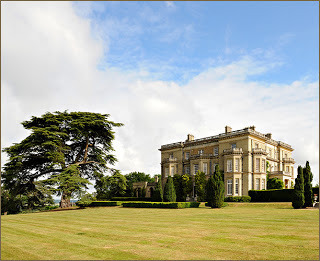 The House was badly damaged by fire in 1795 and a new house was completed in 1868, unusually modeled on the Italian villa style but with a domed hall rather than an open courtyard. Queen Victoria was a frequent visitor and Baron Boston built the Hedsor Folly, also called Lord Boston's Folly, to commemorate the victory at the Battle of Waterloo. Or perhaps he built it to commemorate King George III's brief recovery from madness. Both theories are in circulation.
The House was badly damaged by fire in 1795 and a new house was completed in 1868, unusually modeled on the Italian villa style but with a domed hall rather than an open courtyard. Queen Victoria was a frequent visitor and Baron Boston built the Hedsor Folly, also called Lord Boston's Folly, to commemorate the victory at the Battle of Waterloo. Or perhaps he built it to commemorate King George III's brief recovery from madness. Both theories are in circulation. 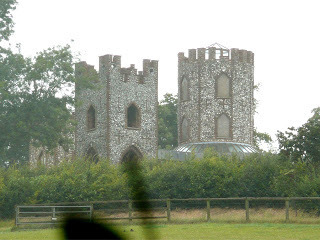
Please leave a comment if you've actually seen either Quartet or the Folly and let us know what you thought of either of them. Or both.
Published on March 27, 2013 00:00
March 25, 2013
A Couple In England - Day Four - Part Two
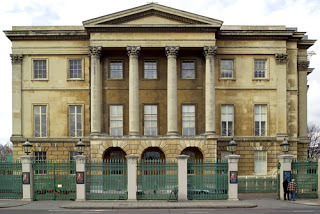
Finally . . . . Apsley House. The Holy of Holies. Honestly, every time I visit I expect the Heavens to part and the angels to sing. Sadly, that's yet to happen.
"Look, Apsley House!"
"Again," replied Hubby, barely containing his enthusiasm.
"Yeah, but this time it's open and we're going in."
"Yipppeeee."
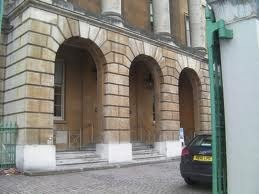
"Wait, come this way. I want to show you something."
"Oh, fer Pete's sake. It's raining. Can't we just go in?"
"No! You have to see this sign first. Victoria and I love it. Come on."
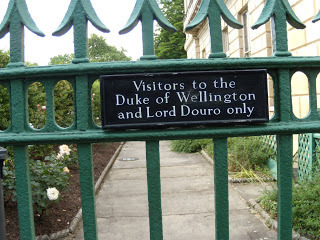
Above is a picture of the sign I wanted Hubby to see, taken by myself whilst with Victoria on a previous visit. I cannot tell you how crestfallen I was when I saw, in it's place, a simple placard that read "Private." I didn't take a photo of it because Hubby was impatient and it was raining, but now I could just kick myself. Can you believe they replaced this sign? Do you think they had to replace it because Victoria and I posted it all over the internet? Hhhhmmmm.
"Okay. Let's go inside."
"Thank you."
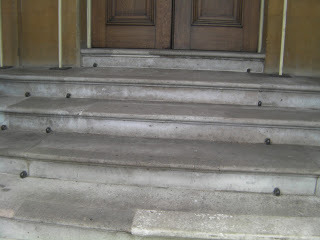
"Wait! Wait!"
"Now what?"
"See those rings on the steps? That's for when they roll out the red carpet. After the carpet is down, they put the rails through those rings to keep it in place."
"Yeah, right. The red carpet," scoffed Hubby. Then he looked me in the eye. "You're not kidding, are you?"
"Nope."
I opened the door and in we went (cue chorus of angels). Now, when you enter Apsley House, you find yourself in a large hall. To the left is the reception desk and till and behind it, on the wall, is a huge portrait of the Duke, at least ten feet tall.
Eyeing it now, Hubby said, "Oh, Jeez. Don't get any ideas."
"Hi, Honey, I'm home," I replied. I approached the desk and paid for two entry tickets.
"Would you like audio guides?" the nice man asked us.
"No."
"Yes, please. Two," I answered, giving Hubby the stink eye. The nice man gave us a brief overview on how to use them and Hubby assured me that he could handle it. "See that guy behind the counter?" I asked Hubby in a whisper as we walked away. "Yeah?" "He knows who the Duke of Wellington is. So does everyone else here. I'm not the only person in the world who knows who Artie is." Hubby rolled his eyes as I led him to the first room on the left. This was called the Museum Room in 1853, when the house first opened to the public and as far as I know, it's still the Museum Room, although back then it was in the room that is now the entrance hall. In the spirit of full disclosure, I should let you know that I didn't take any of the pictures in the rest of this blog post. I didn't think photos were allowed, so I swiped these off the internet. There are links to the original posting where I could find them. The Museum Room contains porcelain, gold and silver gifts given to Wellington by grateful monarchs and countries. In addition, you'll find his swords and staffs of office and the Waterloo Shield, presented to Wellington by the Merchants and Bankers of the City of London.
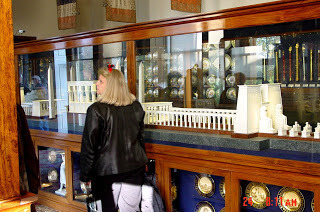
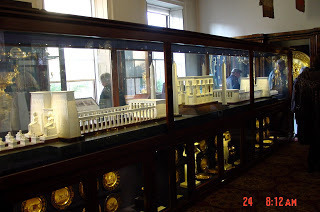
Hubby and I chris-crossed the room as we punched in buttons on our audio guides that matched the numbers on various items.
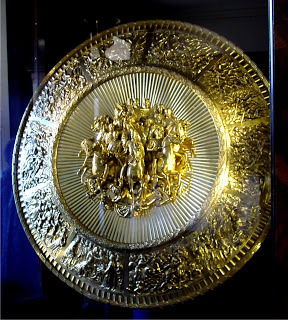
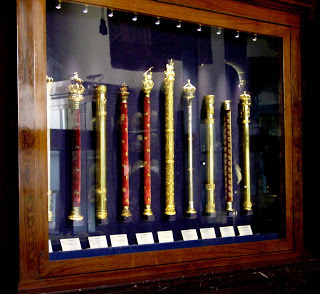
When we had finished looking at all the swag, I directed Hubby to the staircase. "What in the Hell is that?"
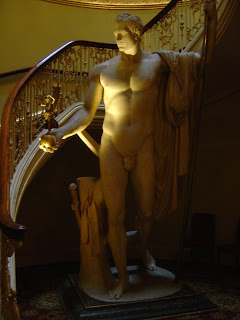
I sighed. "Hideous, no? It's Canova's statue of Napoleon. Napoleon commissioned it, but by the time it was done, his tastes had changed and he consigned it to the Louvre. In 1816, after Waterloo, the British government bought it and King George IV presented it as a gift to Wellington." "He must have been thrilled." "Well, he could hardly refuse a gift from the King, so he had to stick it here, as it was the only place in the house big enough to hold it. They had to reinforce the floor."
I started up the staircase. Whenever I go up or down these stairs, I always do so slowly, with my hand on the banister. I try to imagine Wellington and the Duchess using these same stairs, their hands where mine are now. And all the past visitors to this house - Mrs. Arbuthnot and Lady Shelley. George IV. Lady Burgeresh. The Marquess of Angelsey. Lady Jersey. The Waterloo officers and their . . . . "Jeez, can you go any slower? What's with you?" Sigh. "I'm taking it all in."
"Stairs? You're taking in stairs?"
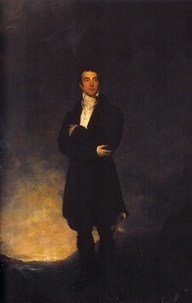
This full length portrait hangs on the landing at the top of the stairs.
I stopped to admire it. "I don't have this one." If looks could kill . . . . . . I deviated from the prescribed tour at this point and dragged Hubby through a back hallway, called the Slip Passage, and into the State Dining Room. "This is where Wellington held the Waterloo Banquet every year on the anniversary of the battle. Wellington would invite all the officers who'd fought with him, and George IV, who only thought he'd fought with him. And that silver centerpiece was given to Wellington by the Portuguese to commemorate Wellington's victories in the Peninsular Wars. It's the one I touched and set off the alarms." "What?"
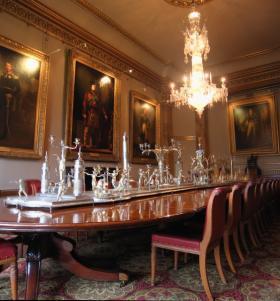
"Yeah. I was here by myself and I was looking at the centerpiece and it appeared to be covered in a layer of dust. I couldn't believe they'd allow it to get into that condition. I was a bit insulted, to tell you the truth." "Of course you were." "So all I did was swipe a fingertip across it to see if it really was dusty and the alarm went off." "A real alarm?" "Yes. A real alarm. Whaaa! Whaaa! Whaaa! The whole bit."
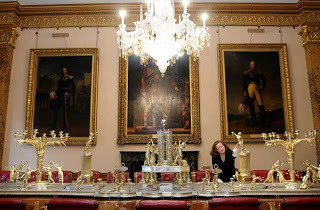
'What did you do?" "What could I do? I was pretty well trapped. I went around the table and stood in front of the portrait of Prinny in a kilt as though I were admiring it. Then a guy in a suit came in and gave me a stare and I turned around and gave him a stare back and then he left and pretty soon the alarm stopped." "He didn't say anything to you?" "Not a word. I found out that the centerpiece had soon after been removed for a thorough refurbishment, but still, they shouldn't have left it covered in dust." "My good man."
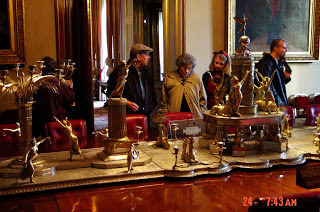
We moved on to the next room, the Striped Drawing Room.
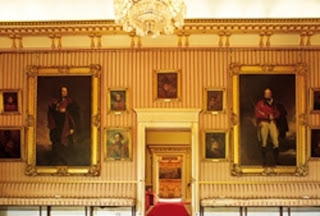
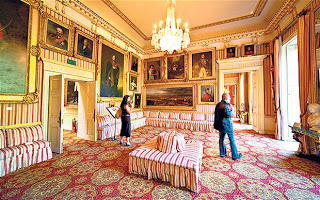
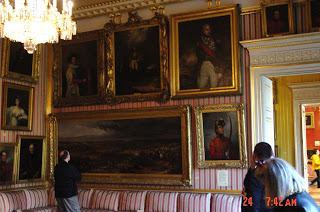 "Wellington used this room as a place where his guests could relax either before or after dinner. There used to be card and game tables set up here from time to time. The portraits are all of people who served with him. Look, here's Henry Paget."
"Wellington used this room as a place where his guests could relax either before or after dinner. There used to be card and game tables set up here from time to time. The portraits are all of people who served with him. Look, here's Henry Paget."
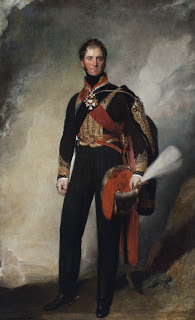 "Who?" "Henry Paget, the Marquess of Angelsey, Lord Uxbridge. The guy who ran away with Artie's sister-in-law. The one who's artificial leg we saw at Horse Guards." "Ah, him again." We sat on the striped couch in the middle of the room and I began to key numbers into my audio guide. "Hey, Hon." "Hhhhmmmm?" "Hon!" "What?" "Artie," Hubby said, pointing to the portrait hanging on the wall before us. "I know that guy." "You should. You walk by him ten times a day. The painting is by Sir Thomas Lawrence." "What number is it?" Hubby punched the numbers in and listened to his audio guide. He actually looked interested.
"Who?" "Henry Paget, the Marquess of Angelsey, Lord Uxbridge. The guy who ran away with Artie's sister-in-law. The one who's artificial leg we saw at Horse Guards." "Ah, him again." We sat on the striped couch in the middle of the room and I began to key numbers into my audio guide. "Hey, Hon." "Hhhhmmmm?" "Hon!" "What?" "Artie," Hubby said, pointing to the portrait hanging on the wall before us. "I know that guy." "You should. You walk by him ten times a day. The painting is by Sir Thomas Lawrence." "What number is it?" Hubby punched the numbers in and listened to his audio guide. He actually looked interested. 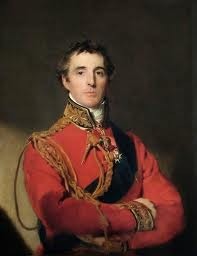 After a time, we moved on to the Waterloo Gallery, which houses the Spanish Royal Collection of artwork. "Most of these paintings were found rolled up in Joseph Bonaparte's baggage carriage after the Battle of Vitoria in 1813," I told Hubby. "Wellington had them framed and hung them here. Then, one day a visitor to this room was looking at the pictures and realized that they were all from the Spanish Royal Collection, which Bonaparte had looted and taken as the spoils of war." "So it was stolen art?" "Yes." "What did Artie do?" "He wrote to King Ferdinand of Spain, told him how he'd come by the paintings and told the King that of course he'd return them post haste. He asked the King to give him directions on how he was to best return them. Did the King want to send someone over to get them? Should he, Wellington, arrange for their return as he thought fit? The King wrote back and told Artie to keep the paintings with his thanks for all he'd done for Spain and the free world. Or words to that effect." "Hhhmmm." "See these two torcheres?" "The two what?" "The pillars with the candelabras on the top." "Yeah?" "Tsar Nicholas gave them to Wellington."
After a time, we moved on to the Waterloo Gallery, which houses the Spanish Royal Collection of artwork. "Most of these paintings were found rolled up in Joseph Bonaparte's baggage carriage after the Battle of Vitoria in 1813," I told Hubby. "Wellington had them framed and hung them here. Then, one day a visitor to this room was looking at the pictures and realized that they were all from the Spanish Royal Collection, which Bonaparte had looted and taken as the spoils of war." "So it was stolen art?" "Yes." "What did Artie do?" "He wrote to King Ferdinand of Spain, told him how he'd come by the paintings and told the King that of course he'd return them post haste. He asked the King to give him directions on how he was to best return them. Did the King want to send someone over to get them? Should he, Wellington, arrange for their return as he thought fit? The King wrote back and told Artie to keep the paintings with his thanks for all he'd done for Spain and the free world. Or words to that effect." "Hhhmmm." "See these two torcheres?" "The two what?" "The pillars with the candelabras on the top." "Yeah?" "Tsar Nicholas gave them to Wellington."
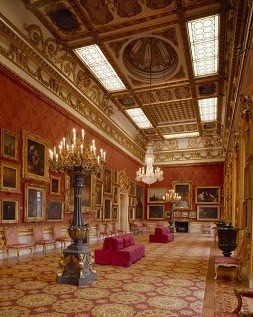
"Originally, this room was hung in yellow damask. Wellington's good friend, Mrs. Arbuthnot, helped him with Wyatt's redesign of the house and she and Artie argued over these walls a good deal, but in the end Wellington won." "Well, yeah. It was his house. Why aren't they yellow now?" "Wellington's son, the second Duke, had them changed." "Because of Mrs. Arbuthnot?" "No. She'd died in 1834. He didn't become the Duke until 1852. Times had changed, tastes had changed, that's all. Wellington designed a heating system that's hidden in the ceiling," I said, prompting us both to look up. "And see those windows? Wellington designed them so that mirrors hidden in recesses in the wall could be pulled over them at night. When he gave evening entertainments, the mirrors reflected the candlelight throughout the room." "Hunh." I walked over to one of the windows and peered out at Hyde Park. "I was here once with Brooke and we were looking out this window when we saw a whole regiment of soldiers out there doing drills in their dress uniforms. After we'd left the house, we went around into the Park and Brooke asked one of the soldiers what they were doing. Without missing a beat, he told her, 'We're male strippers and we're practicing our routine.'" "Come on." "I swear. You should have seen her face. Then he told her what they were really doing, which was practicing for some official do that was to take place in a few days time." "Only you could have such crazy stories about Apsley House." I waved a hand at him. "That's nothing. The last time I was here with Victoria we watched as hundreds of naked bike riders rode past." "Get out." "Fact. It was the annual Naked Bike Run, or some such thing." "Naked?" "As the day they were born." "Men or women?" "Both." "Bicycles or motorcycles?" "Bicycles." "Ouch." "See? I told you that Apsley House was fun and you wouldn't believe me."
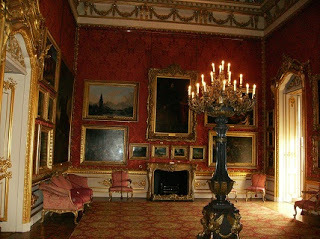
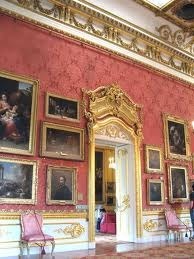 We went out this door and into the Yellow Drawing Room. "That's an original Adam's fireplace," I said. "Who's Adams?" "Never mind." We moved on to the Portico Drawing Room
We went out this door and into the Yellow Drawing Room. "That's an original Adam's fireplace," I said. "Who's Adams?" "Never mind." We moved on to the Portico Drawing Room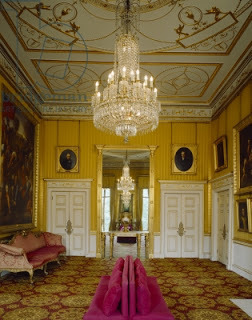
"See this painting here? It's Charles Arbuthnot."
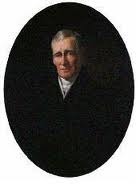
"Husband to the interfering Mrs. Arbuthnot?"
"Harriet, yes. After she died, he lived with Wellington, both here and at Walmer Castle. They were both widowers, as well as great friends, so the arrangement worked for both of them. Arbuthnot died in this house. So did Kitty, Wellington's wife, come to think of it."
We went through to the Piccadilly Drawing Room, probably so called because the windows look out over Constitution Hill and Piccadilly.
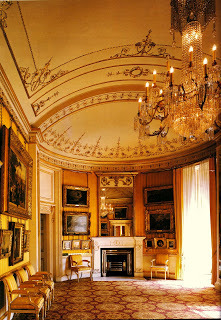
"This is my favorite room in the house. I love the proportions of it. The Adams ceiling and how it mirrors the curve of the end wall. The moulding detail. The picture rails. And the view. I always stand at this window to admire the view," I said, looking out at Wellington's statue and the Arch beyond. I stood this way for several minutes and then decided that I'd tried Hubby's patience long enough. "Come on. Let's go down to the basement." "The basement? We're not going to set of any alarms, are we?" No, it's part of the museum. The most personal part." Once we'd gotten downstairs, I showed Hubby the displays that include Copenhagen's saddle blanket, Wellington's medals, his traveling cases and, naturally, a pair of his boots.
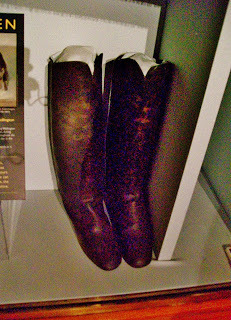 Finally, we approached a display case dealing with Wellington's death and State funeral. "Look," I said, pointing at a shelf in the case. "Who's that?" "Wellington. It's a death mask. It was taken soon after he died." "It doesn't look like Wellington." "Sure it does. Wellington was in his eighties when he died. The Thomas Lawrence portrait was far in the past by that time."
Finally, we approached a display case dealing with Wellington's death and State funeral. "Look," I said, pointing at a shelf in the case. "Who's that?" "Wellington. It's a death mask. It was taken soon after he died." "It doesn't look like Wellington." "Sure it does. Wellington was in his eighties when he died. The Thomas Lawrence portrait was far in the past by that time." 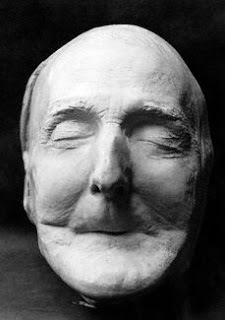
"You ready to go?" I asked at long last. "Yeah. What's next?" "Our three hour rock and roll tour. Three whole hours without mention of the Duke of Wellington." "I gotta admit, Hon, Apsley House wasn't as bad as I thought it was going to be. It was pretty interesting." With Herculean effort, I refrained from saying told you so. You can take a short video tour of Apsley House here. Part Three Coming Soon!
Published on March 25, 2013 00:00
March 22, 2013
The Secrets of Bloxley Bottom, Episode 7: Misses and Near Misses
Prudence Newton glanced up from her prayer-book as Mrs. Aurelia Gammersgill bustled down the aisle to her usual place in the third pew. Prudence stifled a grin. With those frills and trimmings on her bonnet, Mrs. Gammersgill looked more than usual like a placid sheep ready for shearing. In contrast, Mrs. Millicent Oldstead-Parker, who followed close upon her heels, cast a foxy and appraising look upon the congregation as she went, her sharp eyes missing nothing.
The two ladies were no sooner settled than Mr. Neville Newton stood at the pulpit and began to speak. Prudence bowed her head in a show of piety, though the assembled congregation would have been surprised if they could have read her thoughts. She sat beside her mother in the rearmost pew of All Saints church as her father's voice droned on. She was careful not to let her chin droop to her chest, as many parishoners were liable to do.
At age seventeen, Prudence Newton was at present dissatisfied with her life and most especially dissatisfied with her parents expectations for her. As their only child, they expected a great deal of Prudence. Most annoyingly, they took for granted that she would marry a clergyman and post haste provide them with many grandchildren for the pair of them to dote upon.
As much as she loved her parents, Prudence knew that she was bound to disappoint them in this regard, for Prudence had ambitions for herself beyond the boundaries of Bloxley Bottom. She did not want to be a clergyman's wife like her mother, subject to the constant scrutiny of the parishioners. Was her sponge cake as good as Mrs. Noseywood's? Did she sing off-key in the chorale? Did her share of the altar cloth embroidery seem a little crooked? Surely there was more to life than that. For the time being, Prudence carried out her household duties without complaint. She tended her hens and gathered their eggs carefully. Making her delivery rounds through the village was at present her only escape from her mother's phantom illnesses and the vague symptoms that necessitated Prudence's attention throughout each day. Lady Louisa had played a large part in allowing Prudence to hope for more. For several years now, the dowager baroness insisted upon Prudence's weekly visits to the dower house, where Lady Louisa and Miss Anne tutored Prudence in social niceties and graces. They groomed her for a life beyond the confines of a rectory and Prudence was an eager pupil.
Prudence glanced now at the Bloxley sisters, Lady Louisa's own granddaughters, sitting up there in the very front pew, looking as pampered and petted as a pair of spoiled lap dogs. Daphne and Valeria hadn't a care in the world. Their family would make certain that they married well.
How it rankled when Daphne offered to give Prudence that little-worn rose-tinted silk dress with the delicate lace trim. Prudence blushed to recall her eager acceptance of the gift and how she admired the gown. But she had never worn it, for she had never received an invitation to the sort of engagement that would merit its elegance.
How could life be so unfair?
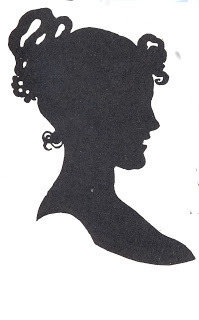 ����
����Later that afternoon, the Bloxley sisters sat in Daphne's bedchamber.
“What is one supposed to do while posing for a portrait? Must you sit very still?” The Honourable Daphne Bloxley wrinkled her nose and grimaced into the mirror above her dressing table. “I am not very pleased with Papa for arranging this caper.”
“Why ever not? I want to be painted. To be immortalized," her younger sister Valeria declared dramatically. "Someday when I am old like Grandmama, I will be happy to remember how pretty I once was. Grandmama loves to stand in front of her portrait in the dining room.”
“Perhaps she is thinking about the days when she was young,” said Daphne.
“She also believes that she is still a great beauty. I think she is really quite vain." “Of course she is! She says even though Mama is also very pretty in her own way, we are fortunate to have inherited our looks from her side of the family.”
“She didn’t say that! I do not believe it,” Valeria protested.
“She did. She told Mama directly. And Mama told me.” Daphne took up a brush and swept it through her long hair.
“Oh, what did she say?”
“I shouldn’t tell you.”
“Yes, you must. I have to know. Please, Daff. “I am not sure I should.”
“Do tell. Please, Daff. You cannot tell me part and not all of it.”
Daphne turned away from the mirror to face her sister. "Mama says that Grandmama married Grandpapa against the wishes of her father, the Earl of Grassington. He thought she should marry at least a man of his own status, and not a mere baron.”
“But wasn’t Grandpapa very rich?”
“I think so, but her father thought she should catch herself a duke.”
“Oh, that would be very easy, I suppose. All those young unmarried dukes crowding up the streets…”
“Well, there were probably some. Even today, there’s Devonshire. He never has married, you know.”
“So set your cap at him next year, Daff.”
“Ha! He’s far too old for me.”
“I don’t think so. Not really. Is that all she said?”
“No. She told Mama that Papa could have married a wealthier heiress than Mama. But that she, Grandmama I mean, was happy that Papa had married for love, because that is what she had done. She loved Lord Bloxley and she married him despite her own father's objections to the match." Valeria covered her open mouth with her hand. “Oh, Daphne, how long have you known about this? Why didn’t you tell me right away? It is so very romantic. " "It was all well and good for Grandmama and Papa to each marry for love. It didn't require their sacrificing anything in order to do so, after all." "I want to marry for love, Daff. Don't you?" Daphne turned back to the mirror and picked up her hair brush. "Well, I wouldn't marry for love alone. Not if it meant that I had to change my present circumstances. Or reduce my dress allowance." "Daphne! You're a fiend." "No. Simply practical, sister dear. Something you should learn to be, else you'll find yourself married to the first handsome face you see and living on love and air alone." "I shan't," Valeria sighed as she lay across her sister's bed. "I shall be deliriously happy with my handsome husband and our fifteen children. And you will be their spinster aunt living on crumbs in our attic, all because you scoffed at love and held out for a wealthy suitor who never materialized." "In your attic?" Daphne laid down her brush, rose from the stool and came across to the bed. "Hhmmm. That's where bitter people live. In attics. And your hair will have turned grey with unhappiness and you'll be all bent over and you'll spend your days counting your guineas like a miser." "If I have guineas to count then I shan't be very poor, shall I?" Daphne sat beside her sister on the bed. "If I had guineas to count, I wouldn't be living in your attic." "I'll lock you in the attic. So that you can't contaminate my children with your bitterness. My handsome husband will hide the key so that you can never escape." Daphne arched a brow at her sister. "Will he?" Valeria nodded. "Oh, yes, he will. And he'll . . . . . no, Daff, no!" "Yes, Val, yes! Tickling is what we bitter old crones do best. Right in the armpits!"
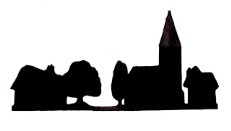
Published on March 22, 2013 00:30
March 20, 2013
Federal Furniture
American Federal Period Furniture at the National Gallery of Art Recently, I met writer pals Diane Gaston and Julie Halperson at the National Gallery of Art in Washington D.C. We had a lot of catching up to do, but we also managed to view some outstanding art. We saw the exhibition "Pre-Raphaelites: Victorian Art and Design," which was organized by the NGA and the Tate Britain. It is showing until May, 2013, so if you have a chance to get to Washington, don't miss it -- a blog piece is coming soon..
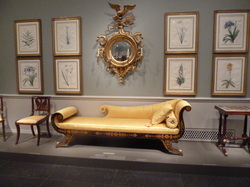
We also enjoyed browsing the collection of American furniture from the early nineteenth century. The exhibit "Masterpieces of American Furniture from the Kaufman Collection 1700-1830" has been on view since last autumn. Shown in my picture is a Grecian couch, attributed to John Finlay (1777-1851) and Hugh Finlay (1781-1831), created in Baltimore 1810-1830, of walnut and cherry paint and gold leaf. Above it hangs a set of botanical prints and a Girandole mirror, New York 1810-1825, white pine, wire, gesso and gold leaf, glass.
The Federal Period in American history corresponds roughly to the extended regency, from about 1789 when the Constitution was adopted to 1828 or so, when Andrew Jackson was elected as the seventh president -- the first who was not associated with the Revolution and a founding father, though in John Quincy Adam's case, he was the son of a founding father.
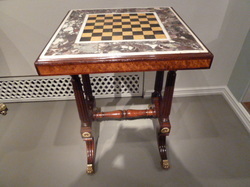
The Gaming table is possibly by Thomas Seymour (1771-1848), Boston, 1815-1820, mahogany and mahogany veneers, various marbles, ormolu (gilded brass), leather and baize (woven cloth). Early America had some superb craftsman who turned out furniture that rivaled the best from England and the continent.
Linda H. Kaufman and her late husband, George M., collected American furniture and paintings for many years, promising the collection to the National Gallery as their first permanent display of federal period furniture.
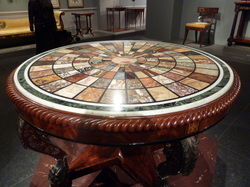
The Center Table has a frame made by Anthony Querville (1789-1856) a former Frenchman, in Philadelphia 1827-1830. The frame is made of mahogany and mahogany veneers, brass and gold leaf with a top imported from Italy made of various marbles and semi-precious stones.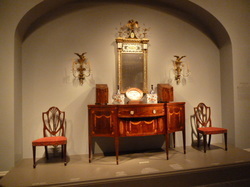
The sideboard was made and labeled by William Mills and Simeon Deming (active 1793-1798), New York; mahogany with mahogany, satinwood, and curly maple veneers and light wood inlays; brass. This sideboard was once owned by Oliver Woolcott jr. (1760-1835), Comptroller and Secretary of the Treasury under George Washington. The looking glass was made in New York 1790-1815 of white pine, iron wire, gesso and gold leaf, glass and paint. The platter is from China, 1800-1820, of hard paste porcelain. A pair of decanters was made in Bristol, England, 1800-1810, of blue glass with gilt. The pair of wine coolers is Chinese, 1720-1740, of hard paste porcelain. The two knife boxes are American, 1785-1895, of mahogany and mahogany veneers with wood inlay and silver. The side chairs are from New York, 1775-1899, of mahogany.
America furniture styles in this period corresponded with British and continental publications such as Thomas Chippendale's Gentleman and Cabinet-Makers Director (London, 1754) and/or traveling experts, artists, and craftsmen.
The dining table below is attributed to John Townsend, of Newport, RI; It is a three-part table, 1795-1899, mahogany and light wood inlay, 71x436 inches.
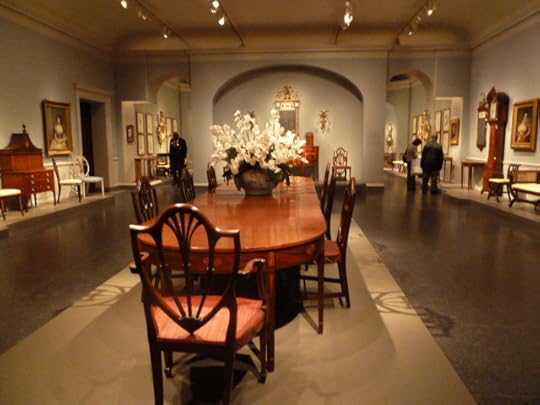
For more information and more details, click here
Many thanks to the generosity of the Kaufmans!!

We also enjoyed browsing the collection of American furniture from the early nineteenth century. The exhibit "Masterpieces of American Furniture from the Kaufman Collection 1700-1830" has been on view since last autumn. Shown in my picture is a Grecian couch, attributed to John Finlay (1777-1851) and Hugh Finlay (1781-1831), created in Baltimore 1810-1830, of walnut and cherry paint and gold leaf. Above it hangs a set of botanical prints and a Girandole mirror, New York 1810-1825, white pine, wire, gesso and gold leaf, glass.
The Federal Period in American history corresponds roughly to the extended regency, from about 1789 when the Constitution was adopted to 1828 or so, when Andrew Jackson was elected as the seventh president -- the first who was not associated with the Revolution and a founding father, though in John Quincy Adam's case, he was the son of a founding father.

The Gaming table is possibly by Thomas Seymour (1771-1848), Boston, 1815-1820, mahogany and mahogany veneers, various marbles, ormolu (gilded brass), leather and baize (woven cloth). Early America had some superb craftsman who turned out furniture that rivaled the best from England and the continent.
Linda H. Kaufman and her late husband, George M., collected American furniture and paintings for many years, promising the collection to the National Gallery as their first permanent display of federal period furniture.

The Center Table has a frame made by Anthony Querville (1789-1856) a former Frenchman, in Philadelphia 1827-1830. The frame is made of mahogany and mahogany veneers, brass and gold leaf with a top imported from Italy made of various marbles and semi-precious stones.

The sideboard was made and labeled by William Mills and Simeon Deming (active 1793-1798), New York; mahogany with mahogany, satinwood, and curly maple veneers and light wood inlays; brass. This sideboard was once owned by Oliver Woolcott jr. (1760-1835), Comptroller and Secretary of the Treasury under George Washington. The looking glass was made in New York 1790-1815 of white pine, iron wire, gesso and gold leaf, glass and paint. The platter is from China, 1800-1820, of hard paste porcelain. A pair of decanters was made in Bristol, England, 1800-1810, of blue glass with gilt. The pair of wine coolers is Chinese, 1720-1740, of hard paste porcelain. The two knife boxes are American, 1785-1895, of mahogany and mahogany veneers with wood inlay and silver. The side chairs are from New York, 1775-1899, of mahogany.
America furniture styles in this period corresponded with British and continental publications such as Thomas Chippendale's Gentleman and Cabinet-Makers Director (London, 1754) and/or traveling experts, artists, and craftsmen.
The dining table below is attributed to John Townsend, of Newport, RI; It is a three-part table, 1795-1899, mahogany and light wood inlay, 71x436 inches.

For more information and more details, click here
Many thanks to the generosity of the Kaufmans!!
Published on March 20, 2013 01:00
March 18, 2013
A Couple In England - Day Four - Part One
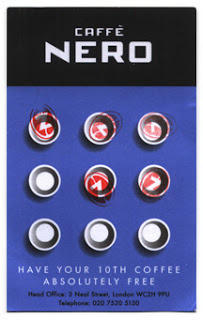
No doubt you'll be shocked to learn that the Hubby and I began Day Four as we had every other day - at Caffe Nero. By this time, we'd gotten a frequent purchase card and were well on our way to getting our tenth cup free. Once again, we took our coffees to a table outside, where we drank up, lit up, woke up and discussed our day. "Apsley House."
"Mmmhhhmmm."
"Oh, God. Here we go."
"You can't listen to everything Brooke says about Apsley House," I advised him. "I promise you it won't be that bad." Before we'd left for England, my daughter, Brooke, had warned Hubby against Apsley House, using words like boring, torture and never again.. In her defence, I do tend to drag her along to Apsley House whenever we're in London. "All I ask is that you go once. Just once. And then I promise I'll never take you there again." I smiled at him over the rim of my cardboard cup. "Look, I only ask for fourteen days in England out of every two years, on average. That's not much to ask, huh? You can put up with England for my sake, surely? And today is Apsley House, or as Victoria and I refer to it, the Holy of Holies."
"Okay, okay. What's at Apsley House, anyway?"
"Oh, well, where to start? There's great stuff to see at Apsley House, even before you get inside."
"Like what?"
"Well, for a start, if there's a Rolls Royce out front when we get there, then that will mean that the Duke of Wellington is in residence."
"Yeah, right. Har har."
"The present Duke. Not Artie."
"There's still a Duke of Wellington?"
Sigh. "The king is dead, long live the king. God willing, there will always be a Duke of Wellington. It's an hereditary title. It gets passed down through the generations. I mean, it's one of the family titles that's passed down. Artie was also the Marquess of Douro and Viscount Wellington. Then there's an Irish peerage, Mornington, which passed down from his brother to the Dukes of Wellington in 1863, so obviously Artie never held that title himself."
"Oh, obviously. My good man."
Sigh. I suppose I won't go into the Duke's foreign titles with Hubby. "The present Duke is the 8th Duke of Wellington. His son is the Marquess of Douro and his grandson is the Earl of Mornington. He's married to Jemma Kidd, the make up artist."
"The Duke is married to a make up artist?"
"Lord Mornington is married to her. The Duke is a widower. It must be awful being any Duke of Wellington other than the first," I mused.
"Why's that?"
"Well, there's no way you can live up to the first Duke, is there? In fact, when Artie was old and frail, someone mentioned to his son, also named Arthur, that he should prepare himself for becoming the next Duke of Wellington. And he said something along the lines of `imagine what a disappointment it will be when they announce the Duke of Wellington and only I appear.'"
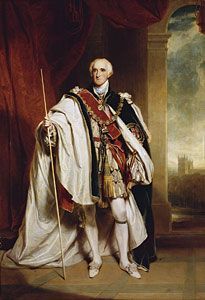
"Huh."
"So, remember when we went to Buckingham Palace and I recognized that portrait of Richard Wellesley?"
"Yeah, that was great."
"Well, after Waterloo, the nation wanted to honour Wellington by building him a grand estate, along the lines of Blenheim Palace, which was built for the Duke of Marlborough after his military victory. Artie saw no harm in this plan and even went out to Blenheim to see it for himself. Well! He took one look at it and put his foot down. He didn't want anything remotely that size. Artie was nothing if not practical and he could visualize the enormous financial burden something that size would place on future generations."
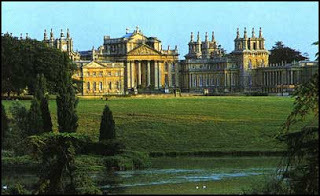
"Besides, Artie was very down to earth. He didn't want to live in a palace, he wouldn't have been comfortable. You know, in a way, you could say that Wellington was the first British rock star."
"Played the electric guitar, did he?"
"After his victory at Waterloo, he was swarmed by crowds wherever he went," I said, ignoring Hubby's remark. "Wellington had to be surrounded by a contingent of guards who tried to keep the public at bay. Women would weep when they saw him and try to grab at him and kiss him, or tear off pieces off his clothing as souveniers."
"What?"
"No joke. Even years later, he was revered. One day he went to some public function and there was an old soldier on the door. The old guy went on and on to the Duke, saying as how he'd never imagined he'd ever get to lay eyes upon the great Duke of Wellington, much less have the honour of opening the door for him. Wellington looked him square in the eye and told him not to be such an idiot. He could never understand the idolatry he received."
"Back to Apsley House. The guy in the portrait at Buckingham Palace was Artie's elder brother, Richard. Unlike Wellington himself, Richard was a bit of a spend thrift, always finding himself in debt. He had bought Apsley House for himself, but then found himself in straightened times. He needed to sell it, it was far too expensive for him to run, and Wellington needed a London base. To his mind, Apsley House was as good a place as any, so he gave Richard a very fair price for the house and thus helped his brother out of debt and got himself a London residence. Two birds with one stone. That was Wellington to a T."
"Huh."
"What's ironic is that Stratfield Saye, the house that the Country did eventually build for Wellington, is still pretty much self-sustaining and it's Apsley House that became cost prohibitive in the end. The Duke of Wellington gave it over to English Heritage, with the provision that the family still has quarters there and uses it as a residence. You ready to see it?"
"As ready as I'll ever be," said Hubby with a sigh.
Part Two Coming Soon!
Published on March 18, 2013 00:30
March 16, 2013
The Smithsonian Institution: The Gift of a British Subject
Victoria here, writing about my annual trip to Washington, D. C. Whenever I can, I visit one or more of the great museums of the Smithsonian Institution, and I always think about the way it got started by a posthumous gift from James Smithson (1765-1829) "to found, at Washington, under the name of the Smithsonian Institution, an Establishment for the increase and diffusion of knowledge." In typical American political fashion, there was considerable debate about how the gift would be used, but by 1846, President James Polk signed the bill that created the SI.
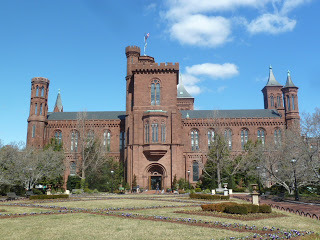 The Red Castle on the Mall, Independence Avenue facade Quoting from the SI's brochures: James Smithson "was born James Lewis Macie in Paris, France, in 1765. His mother was the widow Elizabeth Hungerford Keate Macie of Bath, England, a descendant of Henry VII. His father, Hugh Smithson, the Duke of Northumberland, was actually married to his mother's cousin. After his mother's death in 1800, he officially changed his name to Smithson ...graduated from Pembroke College, Oxford, in 1786, the same year he became a naturalized British citizen...he was the youngest to be admitted as a Fellow of the Royal Society...in 1802, he identified a specific zinc ore that was posthumously renamed smithsonite in his honor..."
The Red Castle on the Mall, Independence Avenue facade Quoting from the SI's brochures: James Smithson "was born James Lewis Macie in Paris, France, in 1765. His mother was the widow Elizabeth Hungerford Keate Macie of Bath, England, a descendant of Henry VII. His father, Hugh Smithson, the Duke of Northumberland, was actually married to his mother's cousin. After his mother's death in 1800, he officially changed his name to Smithson ...graduated from Pembroke College, Oxford, in 1786, the same year he became a naturalized British citizen...he was the youngest to be admitted as a Fellow of the Royal Society...in 1802, he identified a specific zinc ore that was posthumously renamed smithsonite in his honor..."
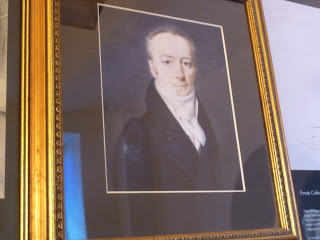 Painting of James Smithson in the Red Castle
Painting of James Smithson in the Red Castle
It is tempting to speculate on Why Smithson left his fortune to the US, a place he never visited. Perhaps he was offended by the way in which the English aristocracy treated him as the illegitimate son of a Duke. Perhaps he admired the experiement in government across the Atlantic. However he made the decision, the result cannot be disputed: a great institution which honors his name.
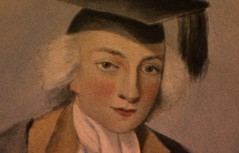 a youthful Smithson, by James Roberts, 1786
a youthful Smithson, by James Roberts, 1786
A chemist and geologist, Smithson died in Genoa, Italy, in 1829 and was buried there. In 1903, Alexander Graham Bell (a Regent of the SI) and his wife bought Smithson's remains to Washington where he is now at rest.
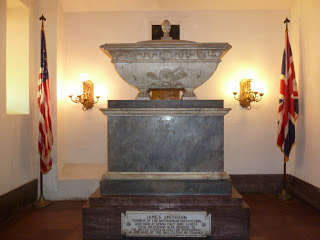 Memorial to James Smithson in the Red Castle The Red Castle, designed by architect James Renwick Jr. in the Medieval Revival style, was the first of the SI Buildings and housed the complete collection and operations for many years. It was remodeled and enlarged after a fire in 1865. Today, the building houses the information center, a few of the original displays, and the ubiquitous gift shop. Below are a few views I took of the Red Castle.
Memorial to James Smithson in the Red Castle The Red Castle, designed by architect James Renwick Jr. in the Medieval Revival style, was the first of the SI Buildings and housed the complete collection and operations for many years. It was remodeled and enlarged after a fire in 1865. Today, the building houses the information center, a few of the original displays, and the ubiquitous gift shop. Below are a few views I took of the Red Castle.
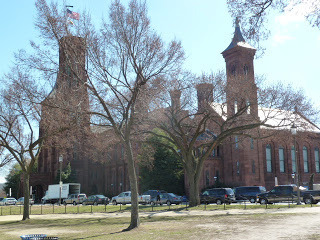 from the Mall
from the Mall
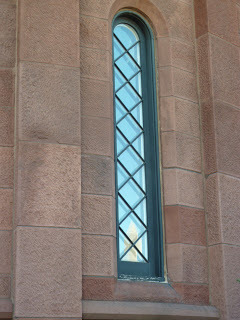 reflection of the Washington Monument in the window
reflection of the Washington Monument in the window
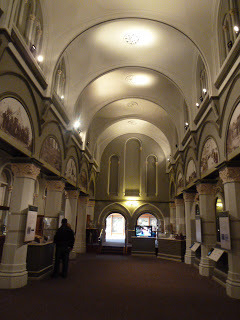 The Great Hall
The Great Hall
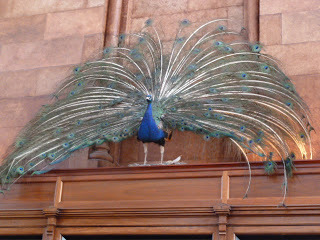 Peacock in the Commons (stuffed)
Peacock in the Commons (stuffed)
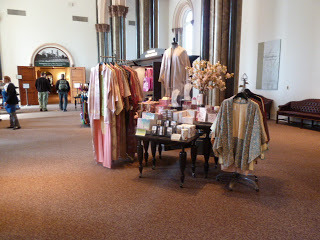 gift shop The Smithsonian has grown to a gigantic size today, with parts of the SI located in many places besides Washington. But it remains in the popular mind, a collection of large and fascinating museums along the Mall between the Washington Monument and the Capitol. Here are a few you might have visited.
gift shop The Smithsonian has grown to a gigantic size today, with parts of the SI located in many places besides Washington. But it remains in the popular mind, a collection of large and fascinating museums along the Mall between the Washington Monument and the Capitol. Here are a few you might have visited.
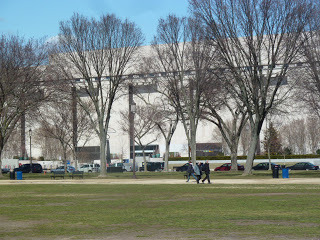 Museum of American History
Museum of American History
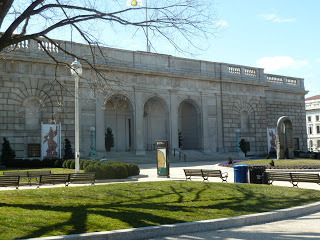 Freer Gallery of Art
Freer Gallery of Art
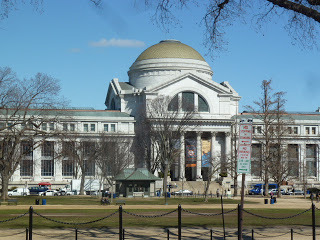 Museum of Natural History
Museum of Natural History
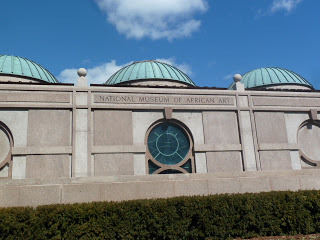 Museum of African Art
Museum of African Art
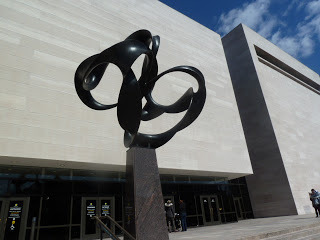 Air and Space Museum
Air and Space Museum
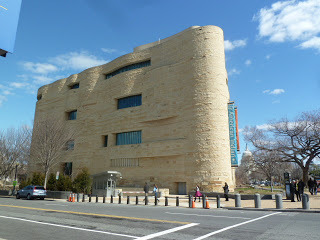 Museum of the American Indian
Museum of the American Indian
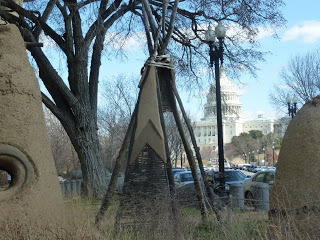 Tipis on the lawn of the American Indian Museum, with the Capitol nearby This is just the beginning of the Smithsonian journey -- in which you can participate by internet, tours, special aps, the magazine and video productions. Just start by clicking here. What would James Smithson think of the results of his gift of about half a million dollars? Since we can only guess why he gave the money in the first place, he could have no way of expecting that his gift would start one of the world's greatest educational and research institutions. Thank you, Mr. Smithson! Soon I will write more about my visit to the National Gallery, a neighbor to the Smithsonian Museums but a separate entity.
Tipis on the lawn of the American Indian Museum, with the Capitol nearby This is just the beginning of the Smithsonian journey -- in which you can participate by internet, tours, special aps, the magazine and video productions. Just start by clicking here. What would James Smithson think of the results of his gift of about half a million dollars? Since we can only guess why he gave the money in the first place, he could have no way of expecting that his gift would start one of the world's greatest educational and research institutions. Thank you, Mr. Smithson! Soon I will write more about my visit to the National Gallery, a neighbor to the Smithsonian Museums but a separate entity.
 The Red Castle on the Mall, Independence Avenue facade Quoting from the SI's brochures: James Smithson "was born James Lewis Macie in Paris, France, in 1765. His mother was the widow Elizabeth Hungerford Keate Macie of Bath, England, a descendant of Henry VII. His father, Hugh Smithson, the Duke of Northumberland, was actually married to his mother's cousin. After his mother's death in 1800, he officially changed his name to Smithson ...graduated from Pembroke College, Oxford, in 1786, the same year he became a naturalized British citizen...he was the youngest to be admitted as a Fellow of the Royal Society...in 1802, he identified a specific zinc ore that was posthumously renamed smithsonite in his honor..."
The Red Castle on the Mall, Independence Avenue facade Quoting from the SI's brochures: James Smithson "was born James Lewis Macie in Paris, France, in 1765. His mother was the widow Elizabeth Hungerford Keate Macie of Bath, England, a descendant of Henry VII. His father, Hugh Smithson, the Duke of Northumberland, was actually married to his mother's cousin. After his mother's death in 1800, he officially changed his name to Smithson ...graduated from Pembroke College, Oxford, in 1786, the same year he became a naturalized British citizen...he was the youngest to be admitted as a Fellow of the Royal Society...in 1802, he identified a specific zinc ore that was posthumously renamed smithsonite in his honor..."
 Painting of James Smithson in the Red Castle
Painting of James Smithson in the Red Castle It is tempting to speculate on Why Smithson left his fortune to the US, a place he never visited. Perhaps he was offended by the way in which the English aristocracy treated him as the illegitimate son of a Duke. Perhaps he admired the experiement in government across the Atlantic. However he made the decision, the result cannot be disputed: a great institution which honors his name.
 a youthful Smithson, by James Roberts, 1786
a youthful Smithson, by James Roberts, 1786A chemist and geologist, Smithson died in Genoa, Italy, in 1829 and was buried there. In 1903, Alexander Graham Bell (a Regent of the SI) and his wife bought Smithson's remains to Washington where he is now at rest.
 Memorial to James Smithson in the Red Castle The Red Castle, designed by architect James Renwick Jr. in the Medieval Revival style, was the first of the SI Buildings and housed the complete collection and operations for many years. It was remodeled and enlarged after a fire in 1865. Today, the building houses the information center, a few of the original displays, and the ubiquitous gift shop. Below are a few views I took of the Red Castle.
Memorial to James Smithson in the Red Castle The Red Castle, designed by architect James Renwick Jr. in the Medieval Revival style, was the first of the SI Buildings and housed the complete collection and operations for many years. It was remodeled and enlarged after a fire in 1865. Today, the building houses the information center, a few of the original displays, and the ubiquitous gift shop. Below are a few views I took of the Red Castle.
 from the Mall
from the Mall
 reflection of the Washington Monument in the window
reflection of the Washington Monument in the window
 The Great Hall
The Great Hall
 Peacock in the Commons (stuffed)
Peacock in the Commons (stuffed)
 gift shop The Smithsonian has grown to a gigantic size today, with parts of the SI located in many places besides Washington. But it remains in the popular mind, a collection of large and fascinating museums along the Mall between the Washington Monument and the Capitol. Here are a few you might have visited.
gift shop The Smithsonian has grown to a gigantic size today, with parts of the SI located in many places besides Washington. But it remains in the popular mind, a collection of large and fascinating museums along the Mall between the Washington Monument and the Capitol. Here are a few you might have visited.
 Museum of American History
Museum of American History
 Freer Gallery of Art
Freer Gallery of Art
 Museum of Natural History
Museum of Natural History
 Museum of African Art
Museum of African Art
 Air and Space Museum
Air and Space Museum
 Museum of the American Indian
Museum of the American Indian
 Tipis on the lawn of the American Indian Museum, with the Capitol nearby This is just the beginning of the Smithsonian journey -- in which you can participate by internet, tours, special aps, the magazine and video productions. Just start by clicking here. What would James Smithson think of the results of his gift of about half a million dollars? Since we can only guess why he gave the money in the first place, he could have no way of expecting that his gift would start one of the world's greatest educational and research institutions. Thank you, Mr. Smithson! Soon I will write more about my visit to the National Gallery, a neighbor to the Smithsonian Museums but a separate entity.
Tipis on the lawn of the American Indian Museum, with the Capitol nearby This is just the beginning of the Smithsonian journey -- in which you can participate by internet, tours, special aps, the magazine and video productions. Just start by clicking here. What would James Smithson think of the results of his gift of about half a million dollars? Since we can only guess why he gave the money in the first place, he could have no way of expecting that his gift would start one of the world's greatest educational and research institutions. Thank you, Mr. Smithson! Soon I will write more about my visit to the National Gallery, a neighbor to the Smithsonian Museums but a separate entity.
Published on March 16, 2013 00:00
Kristine Hughes's Blog
- Kristine Hughes's profile
- 6 followers
Kristine Hughes isn't a Goodreads Author
(yet),
but they
do have a blog,
so here are some recent posts imported from
their feed.



